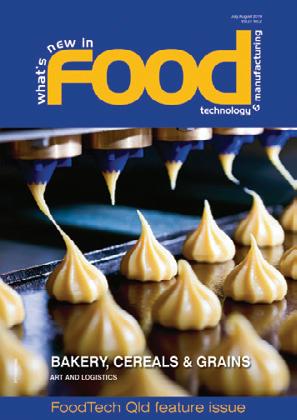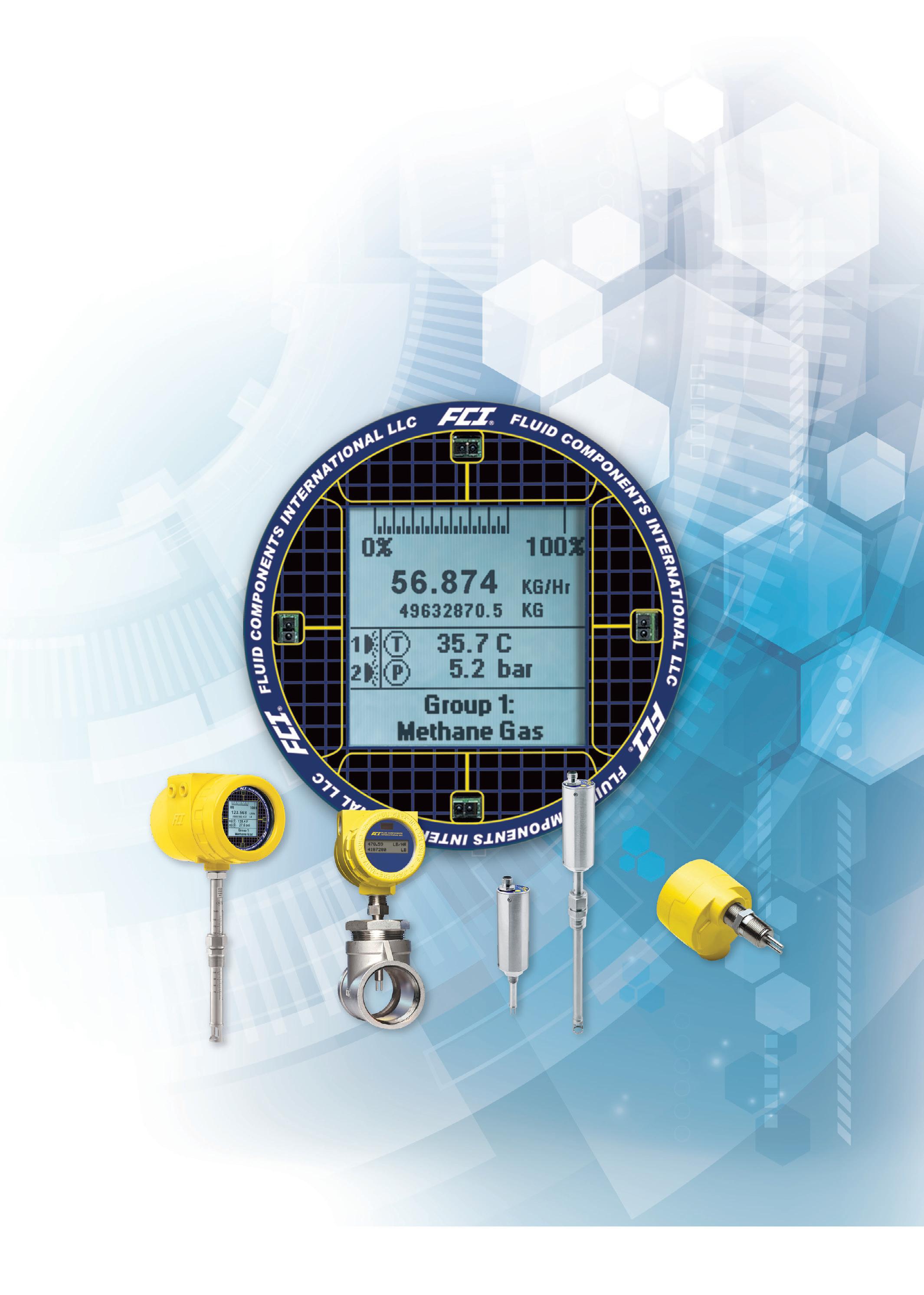






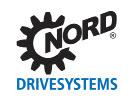


AMS Instrumentation has long been associated with FCI, having been the first overseas distributor for FCI some 40 years ago. Fluid Components International (FCI) designs and manufactures thermal mass flow meters, flow switches and level switches for industrial process measurement applications utilising patented thermal dispersion flow measurement technologies.

FCI products deliver accuracy and reliability to the world’s most demanding processes and industries including chemical, oil and gas, power and energy, water and wastewater, pharmaceutical, pulp and paper, nuclear power and aerospace.

All FCI products are tested and calibrated to rigorous standards to ensure the instrument does the job specified. To design and produce the highest quality flow instrumentation, FCI operates a fully NIST-traceable flow calibration laboratory that is certified to meet such standards as MIL-STD 45662A and ANSI/NCSL Z-540. FCI is committed to high quality, local support and service throughout the world. Factory authorised sales and service centres are staffed with knowledgeable staff comprehensively trained on FCI instrumentation.
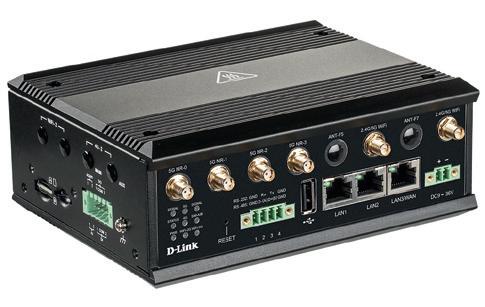
With more than five decades of experience and the world’s largest installed base of thermal dispersion instruments, end users can rely on FCI to know the application and to have proven sensor solutions that will save time and expense.
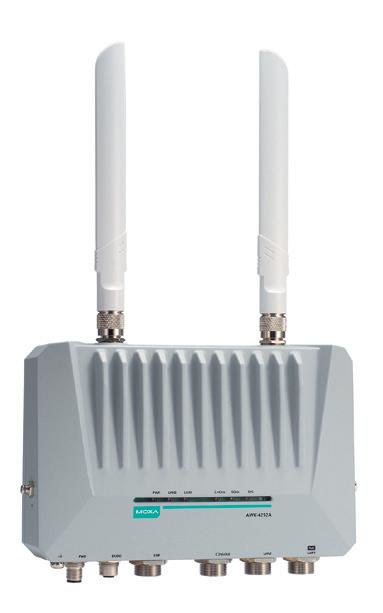

Humans, cobots and industrial robots are all an important part of the mix in the production environment, but the best option is not always immediately obvious.

The introduction of collaborative robot technology has undoubtedly added tremendous value to smart factory strategies. Where once manufacturers could only consider either fully manual or fully automated operations, cobots have provided the bridge that enables businesses to combine the best of both worlds.
One of the huge benefits of adopting cobots is that it opens up a new paradigm of cooperative manufacturing for the factory of the future, with humans and robots working side by side. It combines the advantages of robotics with the many unique qualities that humans bring to the production environment, including creative and holistic thinking, analytical and synthesis capabilities, and precise manual manipulation skills.
While cobots are undoubtedly proving popular, it is also fair to say that they have added complexity to the decision-making process when specifying equipment, with manufacturers having to solve the challenge of unravelling what will work best for them and the potential trade-offs.
To look at how we navigate this decisionmaking challenge, we can start by defining

some priorities. In particular, we can state with some confidence that the key goals of any factory are:
1. The safety and wellbeing of employees.
2. The assured quality of components and final products.
3. The optimisation of production speed and output.
We must prioritise safety of people as there cannot be any trade-offs in this area. Further, we must focus on quality over production volume because this aspect can boost a company’s reputation and image, creating a valuable relationship with customers. The consequences of poor quality can be significant, and quality problems are completely preventable.
Let’s consider the roles of and considerations for human workers, collaborative robots and industrial robots.
We have to consider that different workers, be they long-term employees, new hires or seasonal workers, will all have different skillsets, attributes, abilities and training requirements.
Cobots are a technology that by definition fulfils the requirements of two key international standards, ISO 10218 and ISO/TS15066. The second of these in particular is hugely important, as it provides detailed guidelines for the use of collaborative technologies.
When we discuss cobots, although they will typically be working with humans, we should not assume that this is the only possible work environment for them. When humans are not present, cobots can have the freedom to work at high speed and with high precision, and do not necessarily need to continue working at slow, collaborative speeds.
Here we are talking about more traditional robots. These robots will typically operate in an area separated from the human workspace.
This is an additional category of robot that needs consideration: a standard industrial robot equipped with a safety area scanner. Such technology, fully certified with the appropriate safety standards, allows humans to move around and through the
Robotics
area where robots operate. As the human gets closer, the robot will slow down at the initial approach and stop completely should the human continue to approach.
Safety in a factory is not simply about what safety equipment is being used on the plant floor. It has to be based on a holistic view that encompasses the requirements and likely actions of every employee, and it has to be managed from the bottom up.
When we think about humans working with robots, the collaborative robot is considered an inherently safe option, as defined by the two ISO standards highlighted above. However, the surroundings that the human worker interacts with and handles, for example, need to be considered as part of the cobot installation, and there needs to be a risk assessment to understand if the production process is suitable for adaptation to human–robot collaboration in a safety context.
The traditional industrial robot, due to its speed and footprint, has to be physically separated from that of humans, or the robot needs to be equipped with safety area scanners that recognise the approach and presence of a person and can stop the robot. Selection of an appropriate system depends on the requirements of the application. If the production process is repeatable and doesn’t require changeovers, then an enclosed robot cell might be the right solution. In a low-volume, high-mix production environment where some level of access to the robot work area or interaction with the robot itself is required, then safety scanners can be a better option, significantly increasing overall flexibility.
Mistakes in manual assembly can have significant ramifications. But the frequency of such errors can be minimised or even eliminated through:
• thorough and detailed employee training
• poka-yoke (pick to light) solutions that guide an operator’s actions.
The effectiveness of these strategies can be further enhanced through automated quality inspection using, for example, highspeed vision systems.
Alternatively, companies can look to automate manual processes; cobots offer the same precision as industrial robots, so production quality can be assured. In addition, cobots can be quickly repro -

grammed to handle new tasks, without sacrificing precision.
Among other human–cobot cooperation strategies, cobots can be employed for the inspection of the finished product in a manual assembly process, or the human could be inspecting the work of the cobot. In a lifting and fitting task, the cobot could handle the heavy lifting while the human takes care of the positioning and fitting. In all cases, humans and cobots work together, combining the best attributes of each to deliver the highest quality end product.
For companies looking to automate a complete and repeatable process without the need for regular human interaction, an industrial robot can be the best fit. It will carry out a pre-programmed task with repeatable precision and consistent quality. It can require more time and effort in programming complex tasks, but this only has to be done once. If you have highvolume production, the industrial robot can bring the greatest benefits in terms of quality and volume.
Where volumes are a little lower or where some level of action by human operators within the cell is still required, an industrial robot equipped with a safety scanner can deliver increased flexibility while maintaining the highest levels of quality.
The conclusions of production volume considerations are, unsurprisingly, similar to those of the question of quality. While a cobot works much slower than an industrial robot by virtue of the fact that it is cooperating with humans in close proximity, it can still provide a significant production boost. This is especially true if it is allowed to work more quickly when humans are not present, while also using a safety scanner for example.
The greatest production volumes, though, where the process allows it, will always be given by an industrial robot working behind physical barriers. At the other end of the scale, human-only assembly will generally yield the lowest production volumes, even if supported by a poka-yoke guidance system.
In a state-of-the-art production environment, opportunities for further improvements in speed and quality may not be easy to find. Manufacturers therefore need to look elsewhere to gain additional competitive advantages. One important answer is data:
asset data and production information can yield an enormous business advantage.
It is important that the data generated by assets can be easily integrated into the systems that can process them the likes of edge computers and data science platforms need access to data quickly, fully and with low latency.
To ensure the best practical use of the data, making use of it for decision-making as early in the process as possible is best as early, in fact, as in the robot itself. This is where modern robotic technologies bring huge benefits, as the data science is implemented by default in the robotic application as an inherent feature of the robot arm and controller. Robots and cobots can be auto-diagnosed thanks to implementation of AI-driven tools.
When a higher level of analysis is required on data from a greater number of devices, edge-level data science is the next step up, but still close enough to the production environment for real-time decision-making. The edge computer can aggregate and analyse data from a number of different sources, without that data having to leave the environment where most of the manufacturing requirements are handled.
Present costs and future changes to those costs might be another influence on any production investment decision. The tech -
nology footprint of a system is an important factor, and the upfront cost, set-up implications and ongoing training requirements can be a barrier to entry. But the longer-term implications of any decision should be the decisive consideration. Labour costs are rising and will only continue to rise; designing new applications that are built around a reliance on human work might not be a sustainable long-term strategy. Something that today is considered a worthwhile trade-off might become a future burden. And with societies getting older, it might not be long before availability of employees becomes another, and perhaps an even more important, factor.
While there are undoubted costs in embracing technology, it is important to balance the cost of introduction with the benefits to be reaped in the production environment once the technology is up and running. For repeatable, high-volume operation, an industrial robot cell could quickly pay back its higher initial costs, providing the best option. Where high flexibility is required, a cobot will probably be the best option, and provide the lowest cost of entry.
If only one message from this article is remembered, let it be this: there need not be any trade-off made in the choice between cobots and industrial robots.
While cobots can of course be programmed using simple and intuitive visual tools to speed
up installation and deployment undoubtedly a great part of their appeal they can also sometimes be programmed in the same tools that you’d use with an industrial robot arm. This means that different options can be considered at any time, and production-related decisions are not absolute and inflexible, but can be changed and adapted as required.
In this respect, cobots can be regarded as a bridging technology between an entirely human production environment and an entirely robotised production environment. This is even more the case for cobots that can be run in a higher speed mode in a ‘cooperative production’ setting.
Futureproofing the production environment is built on flexibility. It relies on an appreciation that production requirements may shift over time, and an understanding of how this might happen. It also needs a willingness to consider the way supply and engineering chains might change. You might think that futureproofing the production environment therefore implies a high cost, but the technologies that support the required flexibility don’t have to be expensive.
Another important point to reiterate is that standard industrial robots are much more flexible than they are given credit for.
It is true that they require a bit more time for programming and engineering, but they are indeed flexible and can be quickly reprogrammed for other tasks. The decisive factor here is your access to the skills needed to program the robots. If you have those

skills in your workforce, do not hesitate to invest in industrial robots. If you don’t and if you struggle to find those engineering skills in your area, then cobots might be a more appropriate technology solution, where even someone with no programming skills at all can quickly create effective applications.
In a strategic approach to the evolution of production environments, it makes sense to think ahead. Even strategies that are working well today might not be as effective just a couple of years down the line.
Robots and cobots can be hugely beneficial for production facilities, but even in the most modern factories there is still space for humans, who have unique skills and abilities that are hard to replicate with automated equipment. In order to futureproof your factory you need to make it human-friendly but flexible enough to easily pick the best tool for the highest performance outcome.
Humans, cobots and industrial robots are all an important part of the mix in the production environment, but the best option for a given application is not always immediately obvious. The right solution can deliver huge benefits, immediately and in the longer term. Conversely, a poor choice can lead you down a production blind alley.
Mitsubishi Electric Australia www.mitsubishielectric.com.auThe AMS 100i from Leuze is a small laser positioning system designed for tight installations spaces.

Leuze electronic Pty Ltd
https://bit.ly/3LITnQU
The KELLER 26X is a level probe designed for water level measurement in the wastewater treatment industry.

Bestech Australia Pty Ltd
https://bit.ly/3nEZ20S
Noshok provides a wide range of standard, elevated pressure and reduced pressure replaceable and non-replaceable diaphragm seals.

AMS Instrumentation & Calibration Pty Ltd
https://bit.ly/3NYhDQD
The Vecow ECX-1000 is a workstation-grade fanless industrial PC with a wide operating temperature range of -40 to 75°C.
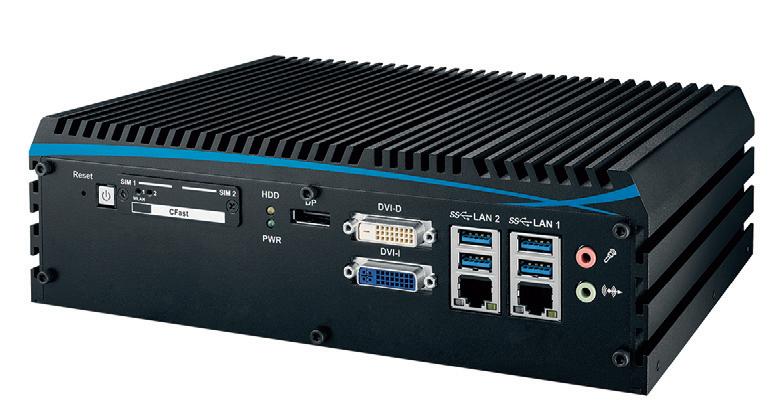
LAPP Australia Pty Ltd
https://bit.ly/40LSivJ
RML Machinery recently partnered with SMC Corporation New Zealand on the design and build of a fully integrated packing line for ice creams. The packing line was produced for a longstanding customer of RML, and New Zealand’s most loved ice cream brand, Tip Top.

“Tip Top has purchased four machine systems from us in the past. Due to the success of our past collaborations, we were selected to work on their latest project,” said Sales and Marketing Manager for RML Jon Marden.
The brief was to design a system that could erect, load and close four different carton sizes and feed these into a case packer with the ability to pack the cartons into five shipper SKUs at a rate of 300 ice creams per minute.
Unique to RML is the use of Codian robots and Gocator 3D vision systems. The Codian robots hit linear speeds of 5000 mm/s and can go up to 7000 mm/s, while the Gocator 3D vision systems are a progression for RML. “Typically, we will use a 2D system for applications like this but found the 3D system gave us better results across the range of ice creams,” Marden said.
Project challenges included the range and speed of the carton erecting and closing.
“In addition, everything needed to fit into a small footprint and the team was up against delivery challenges due to global supply chain issues,” he added.
Adding to this was the concurrent building, testing and commissioning of four complex machines, and ice creams are also challenging to work with in the testing phase.
“The delicate nature of the chocolate skin on the bars meant we had to be as gentle as possible despite needing to process 300 ice cream bars per minute,” Marden said.
It is critical that the ice creams are only held in the machine very briefly, as they degrade quickly if they are not packed and sent to the blast freezers within a set time period. Logic was therefore written into the systems’ code to ensure the delivery of cartons from the loader through to the case packer and into the freezers was balanced to ensure the product quality is maintained.
For this project, RML turned to SMC Corporation. “We were in search of a custom vacuum head solution for the high speed pick-and-place robots and looked to SMC because of our long-established relationship and their customer-centric approach,” Marden said. “As was the case for all of our projects, the team from SMC were involved from the design process right through to testing and commissioning. The team was quick to respond as we needed them at times going the extra mile to supply urgent parts to keep us on track.”
“We were thrilled to be part of this exciting project,” said Laurie Hamilton, National Field Sales Manager for SMC Corporation New Zealand. “In this instance, RML required a high number of outputs for the machine so SMC’s EX600 fieldbus system was selected for the job. Another clever idea that we had was to colour-code the tubing to differentiate between the extension and retraction functions.”
Hamilton added that all parts were engineered locally and that the team was on call throughout. “Our on-the-ground support team made sure that we provided comprehensive support and communicated throughout the process. This made all the difference,” he said.
Detailing the components used, Hamilton shared that the flexi-picker, designed with a custom robotic vacuum head, made use of the ZP3P series of blue vacuum cups from SMC. Every station is also equipped with: SMC’s SY EtherCAT compatible control solenoid valves, the TU series of polyurethane two core tubing to assist in the easy identification extension and retraction of air lines during fault finding and maintenance, and the D-M9 series of solid state autoswitches with a pre-wired M8 connector.
“Other components include the ZP3E series of vacuum cups, the MGPM guide cylinder, the CP96 cylinder, the CQ2 range of compact cylinders, safety rated air service units and more,” Hamilton added.
“Our biggest challenge on any new project is to get to grips with what the customer wants and understand the brief so that we can narrow down the correct solutions,” Hamilton said, reflecting on the project. “We want to reduce the testing time for the customer and try to nail it as close to right as possible, the first time round.”
Design and automate a plant for filling and packaging
44,000 square PET bottles per hour for the largest Italian bottler of mineral water?
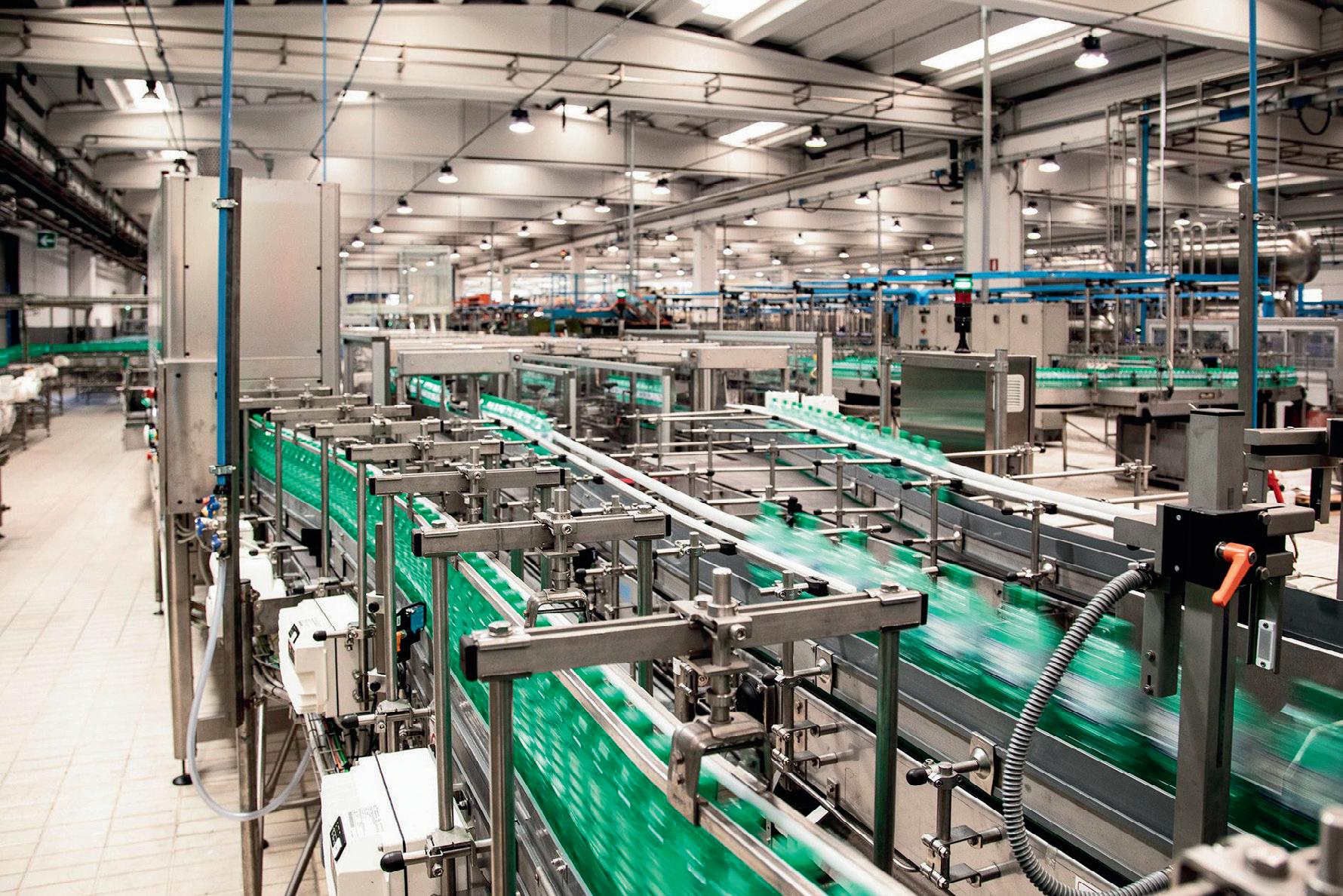
ACMI S.p.A. was faced with this task and developed a plant comprising interlinked machines. The entire process should be productive and three appropriately trained users should be able to control it. Pilz took on the risk assessment and developed the necessary safety measures to ensure safe interaction of the machines. The result is a safe, productive packaging process.
There are many individual steps behind the bottling of mineral water, and therefore many plant components, from the blowmoulding/filler block that blow-moulds, fills and seals PET bottles, a complex design of conveyors conveys bottles to control and labelling stations, and finally to the packaging machines and palletisers.
To determine which risks are possible when operating the plant and which protective measures are necessary, ACMI — a manufacturer of complete end-of-line systems and packaging machinery — consulted with its long-standing partner Pilz. The task was to conduct a risk evaluation of the individual parts of the plant in accordance with the applicable standards and regulations,
including the packing and handling machine, the palletiser and the two different wrappers and depositors. The interfaces between these machines and parts of the line not coming from ACMI were also examined. Pilz identified and documented the risks in the lifecycle of the machinery in order to determine the limits of the linked line.
Finally, the automation experts used this as a basis for conducting a risk assessment in order to draft the optimum strategies and measures for risk mitigation.
In a further step, performed on a second visit, Pilz validated the protective measures implemented, which allowed the RESS (Requisiti Essenziali per la Salute e la Sicurezza — basic health and safety requirements) for reducing the risk of accidents. In Italy, the RESS describes the national, basic health and safety requirements that are part of the European Machinery Directive 2006/42/CE. Pilz also produced the technical documentation and the operating and maintenance manual for the entire production system.
“The risk assessment performed by Pilz experts formed the basis for the safe construction of our plant as well as for the identification of suitable protective measures,” said Gianluca Contesso, Safety Product Manager at ACMI S.p.A. “Pilz’s expertise in machinery safety enabled us to then implement the required measures ourselves.”
At the heart of the system was safe control technology. The safety functions in the ACMI line are now monitored by the configurable small controller, PNOZmulti 2. The PSENcode non-contact safety switches installed on the safety gates of the line also meet the highest safety requirements up to PL e and SIL 3 in conformity with EN ISO 13849-1 and EN IEC 62061.

PSENcode devices monitor the location of guards and perform general position monitoring. Based on RFID transponder technology, the coded safety switches offer both maximum manipulation protection as well as compliance with minimum spacing requirements. In the ‘unique, fully coded’ version — based on the key-and-lock principle — PSENcode guarantees
PNOZmulti 2
PNOZmulti 2 controllers are the second generation of these small controllers with 22.5 mm base units and many extensions for expansion.
PSENcode
PSENcode coded safety switches are used to monitor the position of guards and for general position monitoring. Thanks to the integrated evaluation, applications up to PL e and SIL CL 3 are possible with just one switch.

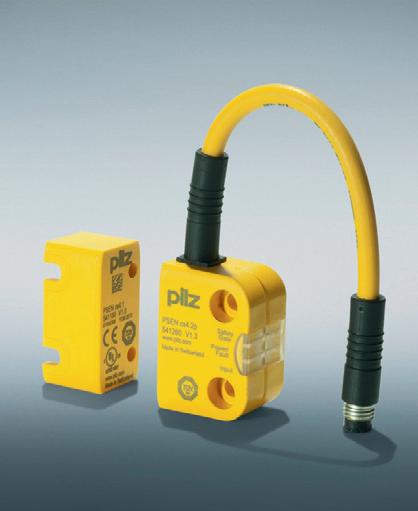
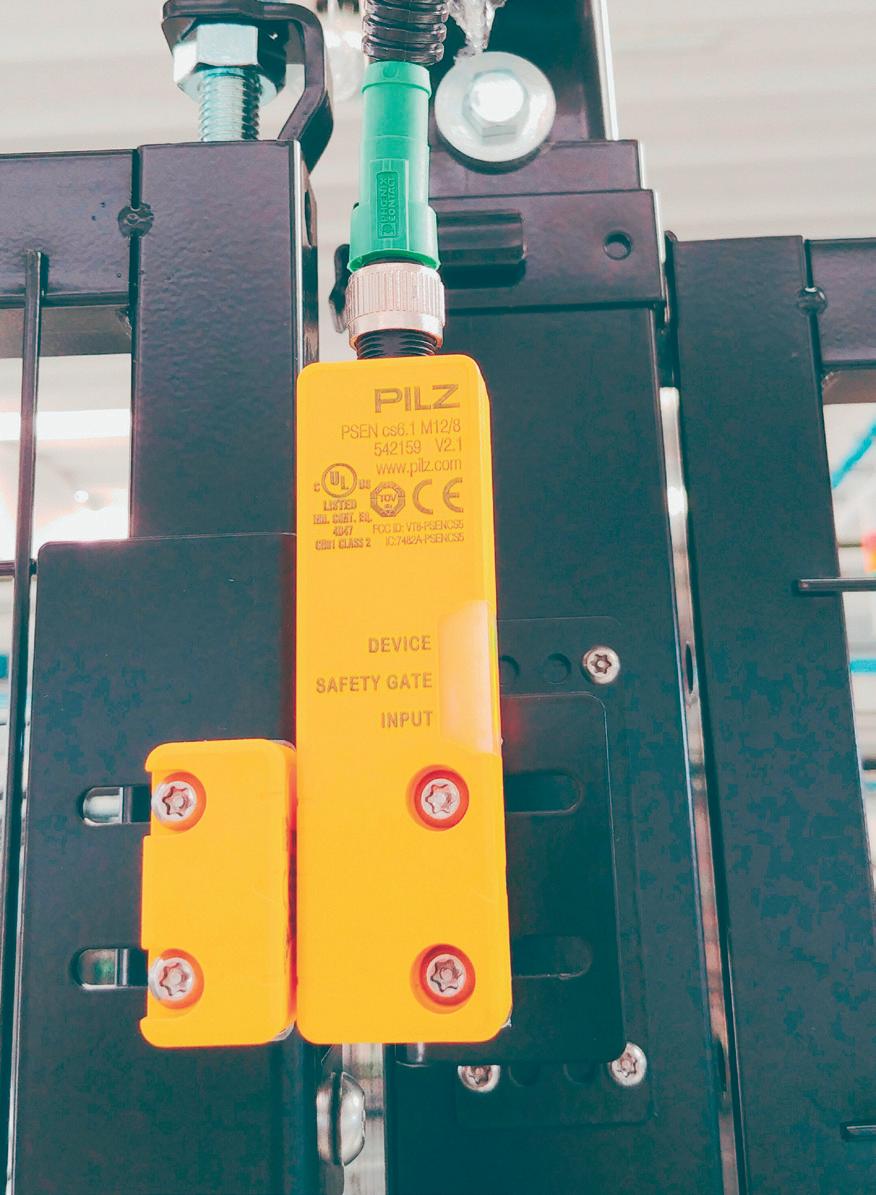
maximum flexibility and user-friendliness while at the same time being easy to install in accordance with EN ISO 14119:2013.
PNOZmulti 2 also offers the option of expanding the safety logic afterwards and controlling other safety functions such as speed monitoring. This solution allows for intuitive operation and the flexibility that ACMI needs. The possibility of connecting the PNOZmulti 2 to the machine’s existing automation system was made possible by the PNOZ m ES Profinet fieldbus, which can be used to communicate the status of the safety devices. This enables fast and simple identification of any problems that may exist, ensuring high productivity from the individual parts of the machine.
It only takes a few clicks in the PNOZmulti Configurator software tool to adapt to other standard PLC controllers as well, which allows both ACMI and the end customer to remain flexible.
• Pilz supports its customers with its many years of expertise in every aspect of risk assessment
• Creation of an individual safety concept according to the current status of the standards, taking into consideration productivity
• PNOZmulti 2 and PSENcode can be seamlessly integrated into virtually all existing automation solutions
OPC UA and MQTT are like polar opposites in the way they move data around, and have different roles when it comes to digital transformation.
The internet expanded rapidly thanks to two technologies. First HTTP, a data exchange protocol, and then HTML, which was used to define the data sent by HTTP. Both technologies were needed, and the explosion of the internet was made possible, and interoperable, by the uniform adoption of these common standards.
Industrial IoT has not yet enjoyed this type of uniform adoption that leads to rapid growth at scale. There are several different architectures and protocols that can be used to gather data on the factory floor and deliver it to data consumers across the enterprise. Some common options are CoAP, DDS, HTTP, MQTT and OPC UA. For the purpose of this discussion we’ll compare two options on opposite ends of the spectrum OPC UA and MQTT/Sparkplug.
OPC UA is the next-generation standard from the OPC Foundation, released in 2008 as an update to the original OPC interoperability standard for secure and reliable exchange of data in industrial automation. OPC classic was released in 1996 and was designed to abstract PLC-specific protocols into a standardised interface to allow SCADA systems to access the data. It is built on a client/ server architecture, in which the OPC server converts the hardware communication protocol, then any program that needs to connect to the hardware utilises the OPC client software.
MQTT is a transport protocol invented in 1999 as a lightweight, publish/subscribe network protocol that allows for multiple data consumers and is designed for constrained devices and low-bandwidth, high-latency or unreliable networks. MQTT is based on a messageoriented middleware approach. Sparkplug is an open source software specification that provides MQTT clients with a framework to integrate data defining a Topic Namespace, State Management and Payload to make the data interoperable for IIoT applications.
Today, many manufacturers or users of process control monitoring have made a choice based on the existing architecture in their environment. If they have a SCADA system, they tend to use

OPC or OPC UA. However, new manufacturers or those looking to digitally transform should consider MQTT/Sparkplug to solve modern challenges and adopt an IIoT solution that can handle any number of data producers and consumers across the organisation.
Back in the mid-90s, hardware vendors were developing PLCs and had to solve the challenge of sharing operational data with other software systems, but every vendor had their own proprietary communication protocols.
As a result, a number of companies worked with Microsoft to try to improve the situation in industrial automation. They became the original authors of OPC.
OPC was developed for Windows, and traditionally requires a dedicated Windows PC, and does a good job of exchanging OT data
with legacy systems on a local area network. OPC uses a client/ server architecture, ideal for connecting PLCs to SCADA and MES systems where OPC and OPC UA are already available. However, there was a call for scalability and a platform-independent architecture, which led to the development of OPC UA.
According to the OPC Foundation, “With the introduction of service-oriented architectures in manufacturing systems came new challenges in security and data modelling. The OPC Foundation developed the OPC UA specifications to address these needs and at the same time provided a feature-rich technology open-platform architecture that was futureproof, scalable and extensible.”
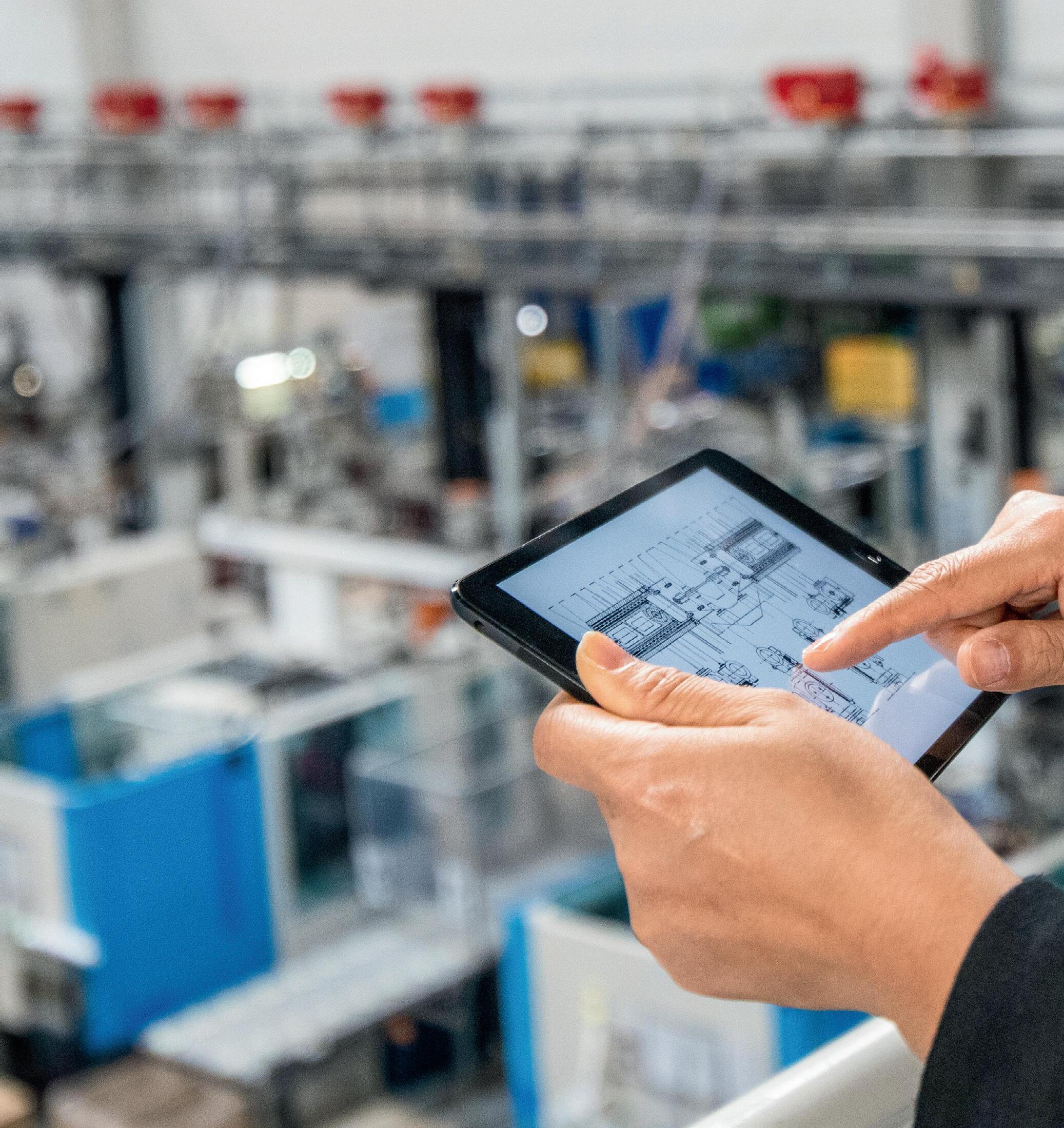
OPC UA aims to expand interoperability to the device and enterprise applications and recently added publish/subscribe to the original client/server communications infrastructure. The specification also attempts to remove the requirement for a dedicated Windows PC by
permitting a server to be embedded into an edge product. The OPC Foundation open-sourced the OPC UA standard to increase adoption.
OPC has several limitations, and OPC UA tries to solve some of these problems but is extremely complicated to implement. The following issues should be considered before implementing an OPC or OPC UA architecture.
The most common complaint about OPC UA, or OPC for that matter, is how complicated it is to implement. The original specification is over 1000 pages and OPC UA is 1250 pages. Many companies do not implement the full OPC Server, and even if they do it also requires routers, firewalls and VPNs. New devices must be configured and connected rather than auto-discovered. Because OPC UA is so complex, it does not often get completely or accurately implemented.
When an OPC server talks to a client, since the subscriptions are not reported by exception but traditionally use a poll/response protocol (other than a very few modern OPC UA implementations), they are very heavyweight. A lot of devices that support OPC cannot handle a lot of subscriptions because they do not have enough storage. This limits the number of data consumers on the system. In addition, even though it is heavy, OPC data only comes with basic tags and values no metadata or objects.
The shop floor is becoming increasingly varied with both modern and legacy devices, different operating systems, network architectures and more. OPC has a hard time handling these varied data structures and heterogeneous devices. Classic OPC and OPC UA implementations usually include an OPC server that talks native protocols to the devices and then clients come and get the data. The focus is on OT data and the solution falls short for big data analytics applications, since it only collects OT data and not IT data.
When OPC UA is fully implemented it is very expensive. The architecture requires embedding an OPC UA server into products, which increases the cost and time-to-market, the footprint size, CPU utilisation, development costs and ongoing support costs.
OPC has been around for many years, but many IIoT technologies do not come with native support for OPC connectivity. Microsoft is the only cloud vendor that uses both OPC UA client-server connections as well as the new OPC UA publish/subscribe connections. Hardware vendor participation has been lacklustre and there are only a few OPC UA software clients available. Typically a shop floor does not have a lot of assets that natively support OPC UA, so they use an OPC UA server to serve the data up to OPC UA clients.
OPC architectures struggle to supply all of the data to multiple data consumers. An OPC UA server does provide ‘one-to-some’ capabilities but does not do the real decoupling needed for ‘one-
to-many’. In addition, most implementations don’t include meta-tag data, which once again means it falls short on getting data to IT functions in a usable format.
A traditional OPC system is shown in Figure 1, where SCADA owns the data path that was built for operations, or OT data. When new consumers request OT data, new application or custom code is written to get the data out of SCADA. As new data consumers are added, a brittle enterprise of applications is built that is costly to manage and becomes too complex to change. The organisation is trapped from moving to new technology without tremendous costs and operational disruption.

MQTT was invented to serve multiple data consumers and multiple data producers. In order for digital transformation to be successful, data must be decoupled and provided over an enterprise-wide solution architecture. MQTT allows for multiple data consumers (Figure 2). Companies can publish the data from a manufacturing asset and multiple applications can consume it, all at the same time.
Sparkplug defines a standard MQTT topic namespace, payload and session state management for industrial applications while meeting the requirements of real-time SCADA implementations. Sparkplug is an open standard that is licence-free to use and builds on 20 years of experience of how to use MQTT. The Sparkplug B specification provides the context data needs to define a tag value for use with OT, also providing data to IT, making it 100% self-discoverable and easy to consume.
Utilising MQTT with the open-standard Sparkplug data representation provides the tools for organisations to build a cost-effective solution for digital transformation across their enterprise. With minimal risk and cost, MQTT allows OT data to be consumed with simple configurations on proven software tools that securely bridge the OT/IT gap and provide contextual information for the data scientists to use big data analytics, ML and AI to gain insight and increase productivity and profit.
The following points explain how MQTT solves the pain points not addressed by OPC UA.
The MQTT specification is 80 pages and Sparkplug adds another 60. Developers can follow the specification and implement it on their own, within a few days or weeks. MQTT is very easy to implement since devices can be added and auto-discovered.
MQTT reports by exception, minimising the data footprint and leading to more efficient communications. The protocol overhead is extremely small, the smallest packet has only 2 bytes of overhead. With Sparkplug, MQTT also includes the essential meta-data with no additional work required, and still keeps it lightweight.
MQTT is based on a publish/subscribe model that decouples data publishers from consumers, which means subscribers do not need to know who provides the information to which they are subscribed. The message can be in any data format for the payload, such as JSON, XML, encrypted binary or Base64, which gives a lot of flexibility to the protocol.
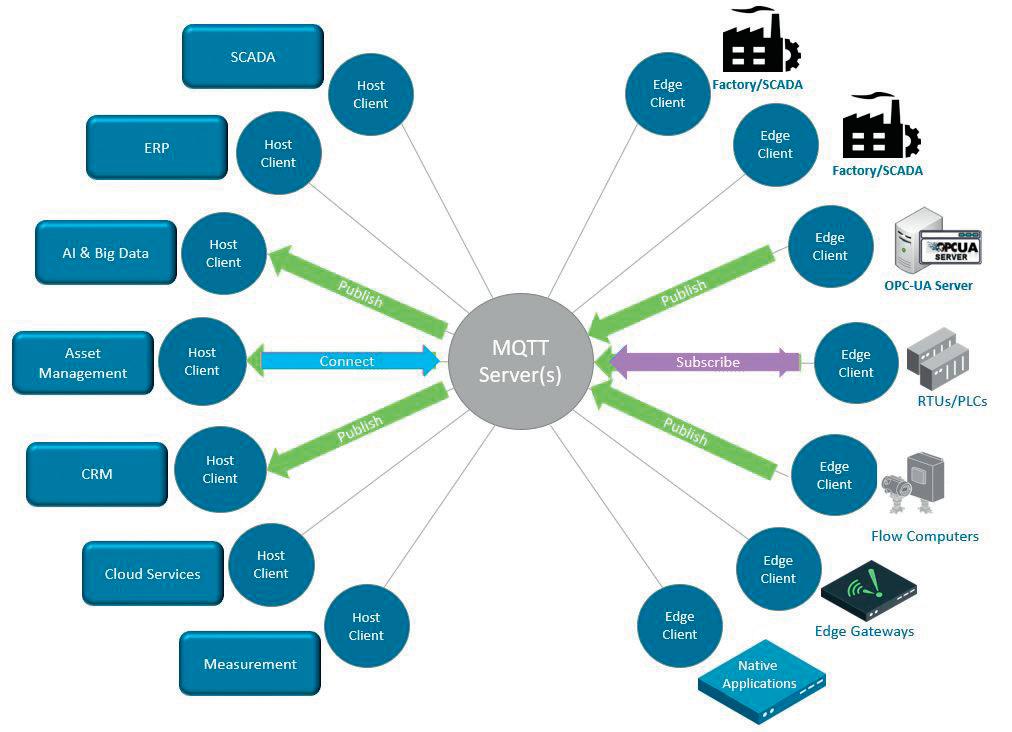
IIoT powered by MQTT provides a cost-effective solution for access to data on brownfield devices. MQTT can transport the data from a sensor, to a device (such as a PLC), to an edge gateway, and then up to the SCADA/MES system on the factory floor.
Secure
MQTT provides security in several ways starting with client usernames and passwords required to log in. MQTT uses the most current TCP/IP layer security available, which today is TLS. Next the connections are remote originated, so no ports are open in the field and only one port at the main firewall is connected to the broker. Access control lists (ACLs) only allow known remote devices to connect.
The number of vendors natively implementing MQTT-Sparkplug, both on the hardware and software side, is growing rapidly. All of the leading cloud vendors, IoT platforms, edge computing platforms, big data and other third-party applications support MQTT.
Progressive cloud providers are implementing Sparkplug to give auto-discovery data modelling.
Supports unlimited data consumers
Moving to a publish/subscribe model with MQTT enables the transition from a one-to-one to a one-to-many approach, encouraging innovations while making it easy to adopt new technologies. Data producers publish the data in Sparkplug B format to an MQTT server. The MQTT server enables those who have secure access to subscribe to the data. The OT application will subscribe to the data instead of polling for it.
It is important to note that OPC UA and MQTT can actually work together harmoniously. They may be polar opposites in the way they move data around, but there are still old devices that need an OPC server to share data and there is a way to use MQTT to overcome the challenges presented. With a sensor connected to a legacy PLC, IoT platforms can connect and translate that data into MQTT, move it across any type of network via the publish/ subscribe model and then either send it to the cloud and enterprise apps or some IoT platforms will translate it back into OPC for legacy OPC clients.
OPC still has a place on a constrained, private network and for a point-to-point connection where multiple data consumers are not necessary. OPC still has a place for a user who is not interested in adding new technologies and new capabilities.
However, if a manufacturer has a choice of purchasing devices that support publish/subscribe with an MQTT-based IIoT platform or native support for MQTT/Sparkplug, an MQTT implementation requires less effort, less money and less time than OPC. Using MQTT allows users to embrace newer IoT technologies and software like big data, machine learning and more. Just as HTTP and HTML worked together to enable the rapid expansion of the internet, so do MQTT and Sparkplug, providing users with a modern option for interoperability of data on the shop floor.
iControls www.icontrols.com.au
Softing Industrial has released dataFEED OPC Suite Extended v5.25, which now supports the integration of production data from XML files.
The company says dataFEED OPC Suite Extended is an all-in-one solution for OPC communication and cloud connectivity, providing access to controllers and IoT devices of leading manufacturers. With the File Read functionality, the suite enables access to brownfield PLCs, devices and machines that deliver data via XML files.
File Read allows process values from XML files to be integrated into production control applications such as MES or OEE via the standard OPC Classic or OPC UA interfaces. The production data can also be integrated into IIoT cloud solutions via MQTT or REST. There is also the option of data logging for documentation, analysis or verification in a separate database.
The suite enables access to the controllers of manufacturers such as Siemens SIMATIC S7, Rockwell ControlLogix, B&R and Mitsubishi as well as Modbus controllers. It acts as a gateway between the two OPC standards so that existing OPC Classic components and applications can be integrated into modern OPC UA solutions for Industry 4.0 applications. Production data is transferred to IoT cloud or big data applications via the MQTT and REST protocols. The suite supports the storage of production data in a file, in an SQL database, or in MongoDB and CouchDB. Due to data pre-processing functionality, data can be easily and flexibly customised.
Ti2 Pty Ltd www.ti2.com.au
D-Link Australia has launched the DWM-3010 5G NR M2M dual-SIM industrial gateway, specifically designed for enterprises and SMBs to address IoT connectivity demands for Industry 4.0.

Industry 4.0 demands large-scale deployment of sensors and monitors throughout smart factories, warehouses, transportation fleets and other industrial settings. The industrial gateway is designed to facilitate private network deployments to ensure low latency for near-instantaneous M2M communications, according to D-Link.
The product has dual SIM slots as well as band support for all major 5G networks in both Australia and New Zealand, along with support for industry standard IoT/ M2M field communication protocols such as Virtual COM, Modbus and MQTT.
With a robust and rugged design, the device is suitable for industrial applications and can withstand wide temperature ranges from -30 to 60°C.
D-Link Australia Pty Ltd www.dlink.com.au
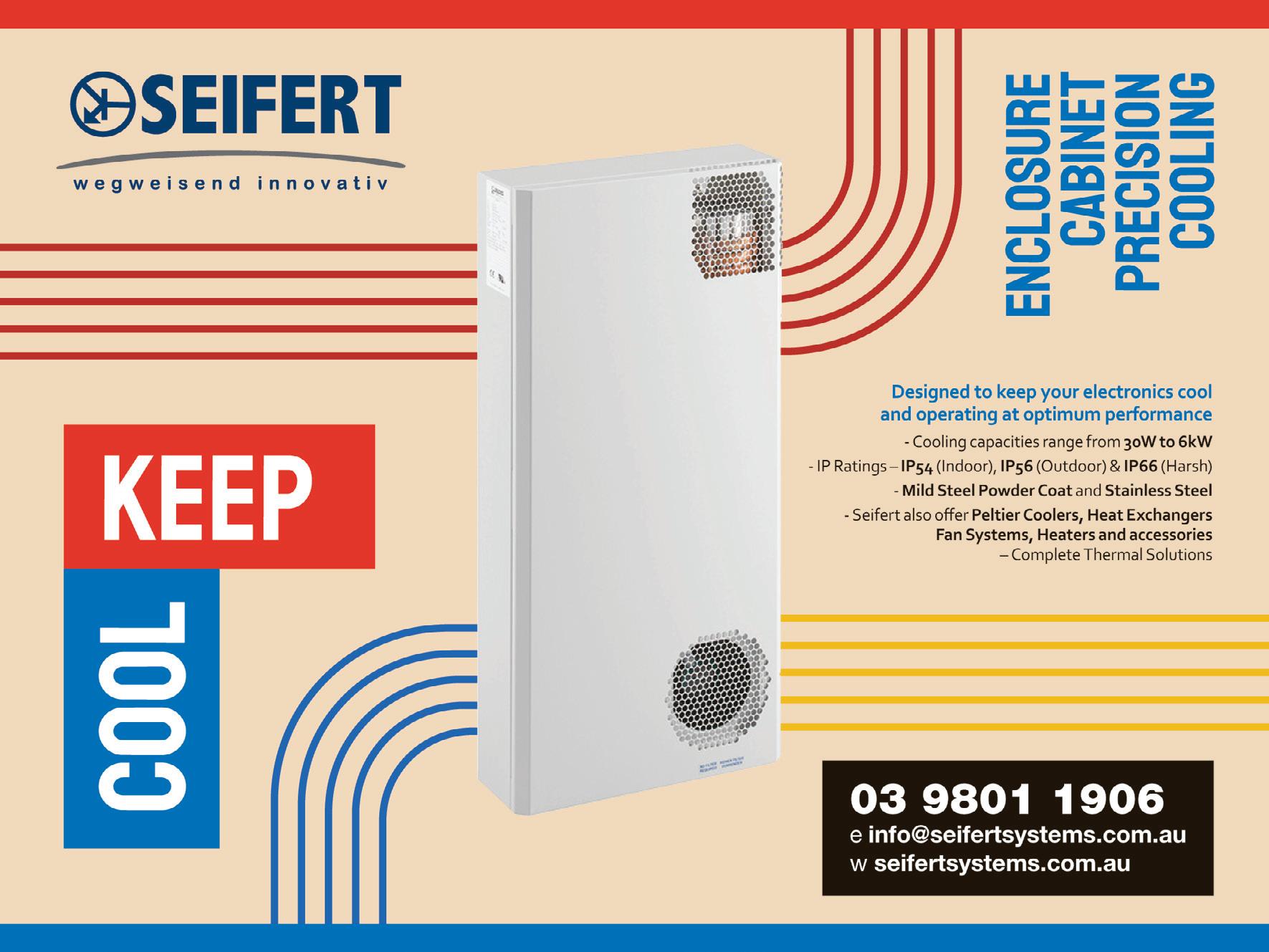


The new year has opened with ongoing volatility and uncertainty for many companies. Amid the longer-term global backdrop touting the dual challenge of meeting the growing demand for resources and higher standards of living from a growing population, while also addressing sustainability goals, the industry must also grapple with near-term uncertainty.
The energy markets have been particularly turbulent in the past year and new emphasis has been placed on a concept discussed for more than a decade: the Energy Trilemma. The World Energy Council (WEC) introduced this index in 2010, highlighting the competing demands of energy security, affordability and sustainability. Since then, the WEC has been charting this balancing act for 127 countries, and the public conversation on this topic gained volume this year.
Globally, process industry companies need to address the impact of the Energy Trilemma on their businesses and communities.
Diversity of supply is an important consideration for energy users, both in terms of types of energy as well as sources of supply. Many countries are moving to expand the use of renewable sources like solar and wind, especially as rapid innovation has helped to lower the cost and increase the availability of alternate energy sources. Policy support and subsidies in the recent Inflation Reduction Act in the US and new flexibility in Green Deal proposals in the EU reflect the eagerness of governments to encourage corporate investment in these growing alternatives.
To support Net Zero targets, many companies in the oil and gas, chemicals and mining industries are working to electrify energy production and process heat to lower the carbon intensity of existing operations. Vendors that provide robust microgrid and distributed grid solutions can reliably integrate these expanding renewable networks. Additionally, geologic modelling capability provides valuable insight for the siting and design of geothermal projects, a rapidly growing alternative power source.
Process optimisation is also a long-established approach to lower the costs of energy production and make fuels more affordable to businesses and consumers. Advanced process control is a crucial solution that many operators use to stabilise operations to avoid energy and product losses that can happen with unexpected process upsets. Digital twins digital simulations of existing assets are particularly valuable when evaluating multiple scenarios, in parallel, to test options and target new levels of operational excellence.
Digitally enabled data management helps operators track and optimise resource use and make better decisions when processes falter or market conditions shift. Many companies have been recording and capturing large amounts of data for decades but lack a data management strategy to unlock its value. Providing context and analysis to this data is fundamental to enable production optimisation to lower energy use and emissions, or to ensure accurate and effective emissions tracking.
With new energy technologies emerging, modelling is an important tool to accelerate research efforts and to cost-effectively scale new production capabilities to meet growing demand. Developing hydrogen, for example, as a new energy source
demands an expansive redesign of the entire value chain, and digital technologies are aiding each step from simulation of new electrolysis processes, to collaborative workflows to scale new projects, to integrated supply chain planning and distribution. With the expansion of renewable energy resources, digital grid management solutions help companies integrate these distributed power sources and manage a smart network of generation and storage solutions.
In relation to sustainability, digital tools have targeted sustainability-related objectives for decades, mainly focusing on energy efficiency, pollution control and value chain optimisation. Traditionally, cost savings drove much of the efficiency efforts, but now companies are moving toward more specific metrics such as the reduction of emissions, effective carbon capture and storage, or the integration of renewable or recycled feedstocks to reflect the environmental impact of operations.
A crucial first step is to gather current data to identify the largest emitters. Digital processes are fundamental for data recording and collection from sensors and unit operations, combining isolated systems to provide an enterprise view. This data can be leveraged to make informed decisions about how operational actions impact CO 2 emissions and waste generation.
With the increase in ESG reporting requirements across regions, the value of data is shifting from general external communications to form the basis for reliable external reporting. Operational data systems must capture the relevant detail and make it easily retrievable and understood, and ready for auditing as needed by local authorities.
Paige Marie Morse helps companies progress toward their sustainability targets providing strategic guidance and targeted digitalisation solutions to the process industry. Prior to AspenTech, she worked for leading operating companies, including Shell, Dow and Clariant, in R&D, commercial and strategy roles. Morse holds a PhD in chemistry from the University of Illinois.

Red Lion has introduced the N-Tron Series NT5000 Gigabit managed Layer 2 Ethernet switches, designed to improve network security and reliability for industrial organisations.


For easy network management, the series provides a simple graphical user interface that includes a logical view showing active ports, power supply, temperature and contact relay status of the switch and colour-coded gauges for port traffic and events to allow administrators to quickly identify and address possible network disruptions.
Designed and assembled in the United States, the switches are available in 6-, 8-, 10-, 16- and 18-port configurations in all copper or a mix of copper and fibre options that can meet specific installation requirements. With a durable, metal enclosure and wide temperature range, the switch is a compact solution for operation in harsh, industrial environments, including factory automation, robotics, food and beverage, and oil and gas.
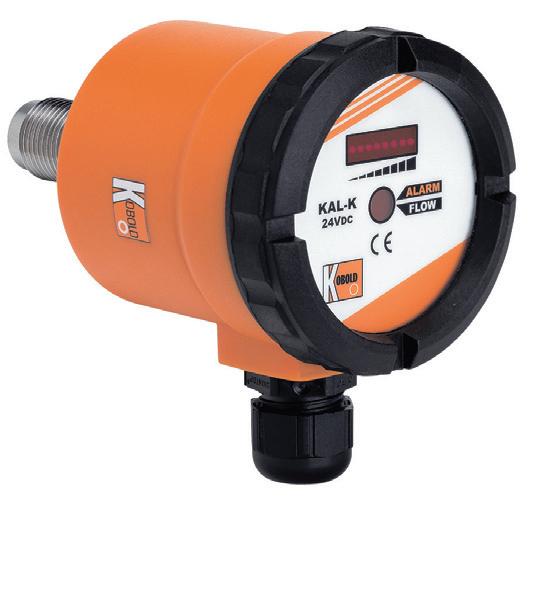
The series features password encryption, multilevel user access and MAC security, and IEEE 802.1X with RADIUS remote authentication. Administrators can view the event log and syslog to see the state of the network in real time and receive notifications about access attempts or configuration changes. The switch can be set to automatically disable user or port credentials after failed access attempts.
The series also features N-Ring auto-member, port mirroring, cable diagnostics, STP/RSTP/MSTP, IGMP v1/v2/v3, SNMP v1/v2/v3, NTP, LLDP and LACP.
IPD Group Limited
www.ipd.com.au
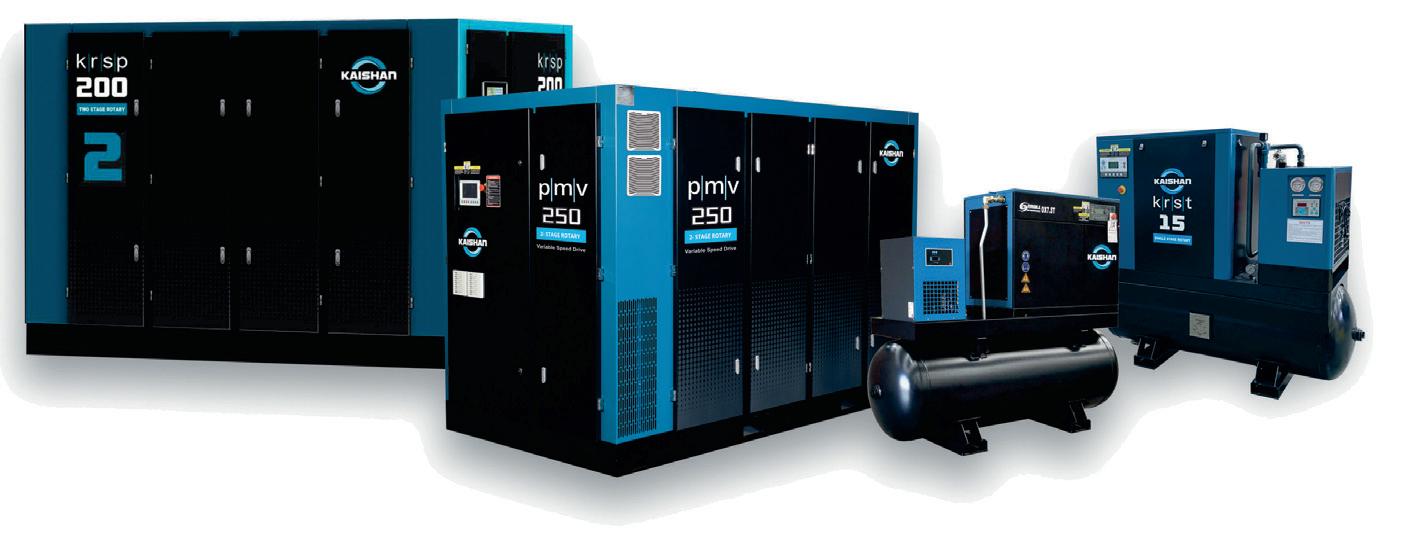
Heavy duty, rotary screw compressors have been the power source of major industries for decades, but like the automobile, though not changing in principle, have come a long way in terms of efficiency, performance and reliability.
New globally developed technologies and engineering advancements mean today’s rotary screw compressors are extraordinary power plants providing high energy output to input ratios. Advanced motor efficiencies combined with new-age single and 2-stage screw configurations provide air compressors that more than meet application demands. Multiple inline compressors can operate huge operations with precise air delivery to meet demand at any time with variable frequency control that automatically limits or shuts off energy intake when not required.
This global development in highly advanced machines has revolutionised the industry to provide a viable, sustainable energy-saving compressed air supply now and into the future.
New compressor innovations include rare earth technology in permanent magnet motors that require far less input power to produce equal or higher air volume output at the application end. Plus the latest developments in variable speed drives eliminate energy wastage through the precise control of compressor air output from nought to maximum, dependent on application demand. VSD programmable air compressor control optimises the co-ordination of the air end, drive motor and compressor to provide much greater air output for far less energy input.
Vast improvements in integrated system configurations and inline components also add to today’s high efficiency compressed air from the compressor to the application end. These new age air compressors are also much more user friendly, safer to operate and much quieter than superseded types and models.
With outdated compressors not meeting sustainable energy efficiency ratios, new advanced energy saving technologies paired with high-precision engineering and modern, quality-controlled production practices, today’s modern industries can utilise and maintain current and increasing production demands with confidence.
In most cases the dramatic reduction in energy and maintenance bills provides a short investment payback period with ongoing savings and operational efficiency.
Demands from small and specialised industries to reduce energy costs, improve reliability and provide a safe working environment, have created the need for a viable alternative to the old piston type air compressor.
Whilst the piston type, reciprocating air compressor has been the workhorse for workshops and smaller industry applications, they can be somewhat inefficient, expensive and noisy in operation.
New-age alternatives like the advanced scroll, fixed orbit, lubricated compact air compressors offer great benefits over the conventional piston type compressors. Scroll technology has produced a compact air compressor with direct drive and dynamic 3D balancing that delivers quiet, stable and energy efficient performance to far outstrip equivalent piston type, reciprocating machines.
With the added benefit of continuous load capability and an integral aftercooler to reduce moisture carry over, the scroll offers a highly reliable compressed air supply with considerably lower energy bills. The dynamically balanced, non-contact, fixed orbit technology also results in significantly longer element life.
Unlike old piston technology, the scroll includes an advanced digital control panel for ease and safety of operation. This provides operators with monitoring of all key compressor functions, fault detection and protection and service due alerts.
Scroll air compressors give higher output ratios to energy input and with fixed orbit direct drive there are zero transmission losses and no need to oversize the compressor to manage load cycles. The direct drive configuration also means there are no drive belts to wear and replace.
The scroll compressor is available as a standalone, or fully integrated, tank-mounted system complete with large 500 litre receiver tank and optional built in refrigerated dryer and air filter unit. This plug-in, ready-to-use compressed air system saves on independent component purchases, installation costs and floor space while efficiently delivering ample clean air for all applicable industry applications.
Whatever compressed air application demands, from running pneumatic tools to operating heavy industry production lines, these recent advances in compressor and in-line technologies mean Australian businesses can continue to utilise and benefit from this highly efficient and sustainable power source for now and well into the future.
Vishal Thakkar, Service Centre Operations Manager, answers some questions about the Emerson Quick Ship and Repair Centre, which provides the local market with more than 6,000 product and service solutions for Emerson’s Rosemount pressure, temperature and DP level instrumentation range, including the capability to locally manufacture and repair remote seals in their Bayswater, VIC facility.
How can Emerson’s local manufacturing facility benefit a business?
Emerson’s Quick Ship and Repair Centre in Melbourne is a purpose-built production and manufacturing facility. It is a replication of the standard factory ordering and supply process with one key difference: all products are locally manufactured which means they can reach Australian and New Zealand customers quickly.

Unlike standard stock solutions where site personnel have to accept whatever product a supplier might have on their shelf (regardless of whether it is overkill for their application), Quick Ship transmitters are manufactured to order, to match the exact site requirements and application needs. All products are fully tested and assembled in accordance with Emerson’s global manufacturing procedures and processes to ensure the product received onsite has the same quality as if it was supplied from one of our global factories.
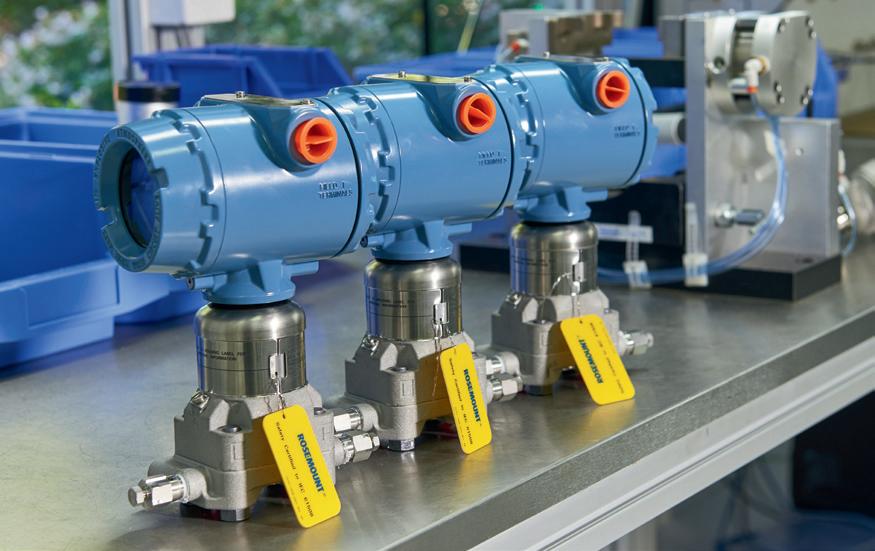
This facility has been specifically designed to provide the following unique solutions:
• Products manufactured to order and customised to match specific site applications.
• ISO 9001 quality endorsed and approved processes by both Emerson and third-party agencies.
• World class testing, calibration equipment and services to match the highest device specifications in the world.
• Certified personnel who are extensively trained in overseas factories and production facilities.
When was this facility built and how it is relevant in the current climate?
The facility was launched in 2014 and includes state-of-art equipment, trained and certified staff, a welding bay, and a large amount of raw inventory of electronics and mechanical components. Since, then the Quick Ship facility has been successfully delivering locally-made transmitters within a week’s turnaround time and often within 48 hours when standard options are chosen.
Although the Quick Ship facility is not completely immune to these global dynamics, the local team has been working jointly and diligently with overseas factories to maintain sufficient levels of inventory to support critical, non-critical and unplanned shutdown demands — that the facility is capable of manufacturing — are still met.
Thus, even in current challenging times, we are serving Emerson customers and even a lot of non-Emerson customers by delivering on the promise that it was initially designed for.
What are the capabilities of the Quick Ship facility?
The Quick Ship facility is ISO9001 quality endorsed with manufacturing and testing procedures in accordance with global factory procedures and processes facility.
With manufacturing and testing procedures in accordance with global factory procedures and processes, the Quick Ship product offering includes over 6,000 combinations for:
• Pressure
• Temperature
• DP level
• Manifolds
• Hazardous area locations
• Safety-certified requirements
• Local industry requirements
What can users expect from using the Quick Ship facility?
Situated in Melbourne, the Quick Ship facility allows quicker local access to global quality products and solutions to assist organisations to achieve operational benefits including:
• Reduced process downtime with emergency product solutions
• Maintained plant uptime through advanced and proactive service support
• Reduced plant inventory volume and costs due to local solutions
Is replacing faulty products with new ones always the best option? What about repairing them?
Since we have access to high quality and very precise factory production equipment, we can offer cost-effective repair solutions
and reinstate devices to original manufacturer performance and specification. As part of the comprehensive repair services program, all product documentation (calibration certificates, pressure testing, SIL documentation, material traceability, etc.) is issued in accordance and consistent with Emerson’s global documentation programs.
Situated adjacent to the Quick Ship facility in Melbourne is Emerson’s National Service Centre consisting of a Repair Centre and a NATA-accredited Flow Calibration Centre.
Repair Centre
Emerson is committed to our own and our customers’ sustainability goals. We reduce e-waste by providing local repair and calibration services for all our instrumentation range including:
• Pressure
• Temperature
• DP Level (including seal repairs and replacements to salvage the transmitter heads)


• Radars and tank gauging
• Liquid and process gas analysers
• Gas chromatographs
• Portable vibration analysers
• Handheld communicators
Flow Calibration Laboratory
Emerson offers a high-precision flow calibration service for worldleading Emerson brands as well as many other flowmeter brands for magnetic, Coriolis and vortex flow meters. The Melbourne-based facility has been designed to stringent engineering and quality standards, achieving ISO/IEC 17025 accreditation and providing an exceptional flow calibration service. We also offer customised calibration and NATA-traceable weight-based calibrations.
What are typical turnaround times for flow meter calibrations?
Typically, flow meters are tested, calibrated, and repaired if required within 10 working days. If a quicker turnaround is required, then we offer a pre-organised express service for same-day turnaround.
Does Emerson offer any other services associated with flow meter calibration?

Yes, we collaborate with other professional third parties to offer professional cleaning services, professional crating and recommissioning.
For enquiries on any of the above services who can we contact?
Apart from the National Service Centre-based service engineers in Melbourne, Emerson has a large team of sales and field service engineers located in Melbourne, Sydney, Brisbane, Perth and Auckland that can be contacted for any of the Quick Ship, Flow Calibration Centre or Repair Centre services. Alternatively, customers can call on 1300 553 051 or write to Emerson at emersonprocess.australia@emerson.com.
A detailed product catalog to build Quick Ship capable model codes can also be downloaded using the QR code.
Emerson Automation Solutions www.emerson.com/au/automation

With the Single Pair Ethernet switches from Phoenix Contact, modern sensors and field devices can be integrated directly into an Ethernet network.
The FL Switch 2303-8SP1 is the first switch from Phoenix Contact to connect modern sensors and terminal devices to Single Pair Ethernet (SPE) interfaces. The managed switch supports SPE on eight ports with the 10Base-T1L standard, which is universally applicable and allows distances of up to 1000 m. The connected devices are optionally supplied by the switch via the two-wire cable with the PoDL (Power over Data Line) standard and 24 VDC Power Class 11. Sensors in production, infrastructure and building automation can thus be integrated directly into the Ethernet network in an installation-friendly manner and without gateways.
Three classic Ethernet ports with 100/1000 Mbps are also available for connecting the higher-level network in star, ring and line topologies. Managed switches are particularly suitable for automation protocols such as Profinet and support network redundancy as well as relevant security features.

Phoenix Contact Pty Ltd www.phoenixcontact.com.au
The ICP DAS U-7519ZM/S OPC UA I/O module has 10 analog input channels, three DO channels and a 2-port Ethernet switch that supports daisy-chain topology. The switch complies with the IEEE 802.3af (Class 2) Power over Ethernet specification, enabling it to receive power via Ethernet pairs from the network.
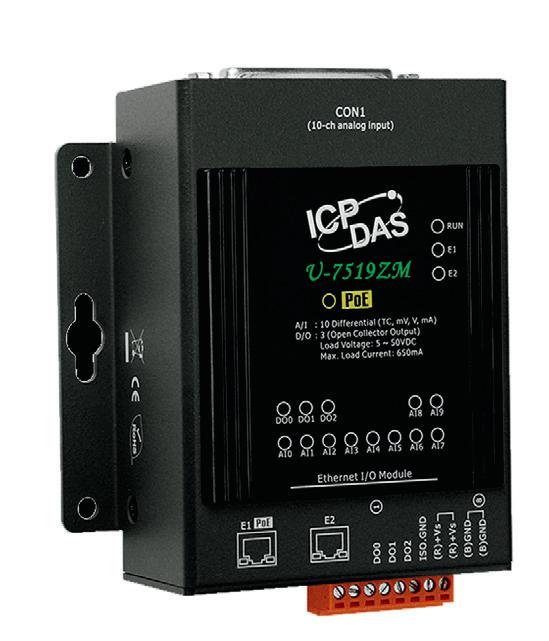
It also offers a web UI so that users with a web browser can configure, manage and keep track of the connections, modules and I/O status.
The module also offers an OPC UA Server, MQTT Client and RESTful API protocols for industrial communication. Users can select the networking mode based on their application, as well as send the data from the built-in I/O channels to a cloud system or field control system for display and analysis.
Supported RESTful API functions can read or write I/O and virtual points through HTTP or HTTPS, and provide a schedule function to execute set rules at a certain time. Supported logic function rules include IF, THEN and ELSE to allow logical conditions and actions.
ICP Electronics Australia Pty Ltd www.icp-australia.com.au
Status Instruments has recently released the DM665 battery-powered digital thermometer gauge designed to replace bimetallic and filled system temperature gauges.

The DM665 is designed to be a highly accurate unit that features PT100 and thermocouple probes (types K, J, T, E, N, R and S) with a number of advanced features including max/min recall and reset from front panel push buttons, IP65 stainless steel housing and up to 3-year battery life with standard AA alkaline batteries or up to five years with lithium batteries. User offset allows simple user calibration for enhanced accuracy. Temperature probes can be made to customer specifications and are offered with fixed or remote mounting with a variety of fittings for all applications.
Applications for the DM665 gauge include food processing, pharmaceuticals, chemicals and general manufacturing.
W&B Instruments Pty Ltd
www.wandbinstruments.com.au
Advantech, a provider of embedded computing solutions, has released three edge controllers — the UNO-127, UNO-148 and UNO-348. The UNO-100/300 series are modular edge controllers powered by high-performance Intel processors.

Aimed at factory applications such as real-time monitoring, data management and remote control, UNO-100/300 edge controllers feature a rugged design with wide operating temperature, shock/vibration tolerance and a built-in TPM 2.0 module to facilitate secure data transfers in harsh industrial environments.


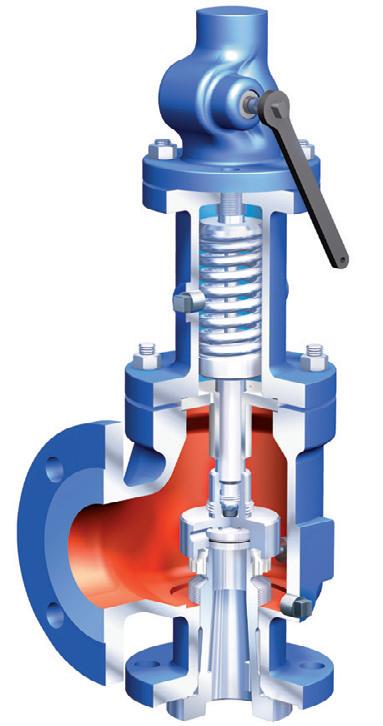
The controllers’ modular form factor allows them to be flexibly deployed and they come with diverse interfaces for optional expansion, such as PCIe for high-density I/O, PCI for motion cards and iDoor expansion for fieldbus modules. This customisable functionality streamlines deployment and maintenance while providing costeffective upgrades, making the UNO-100/300 series of edge controllers futureproof solutions suitable for realising intelligent factory operations.
Equipped with a 10th generation Intel Core i5/i9 processor, Intel H420E PCH chipset and 8/16 GB DDR4 memory, UNO-348 is designed to deliver multi-task processing for enhanced computing capability.
UNO-148 features a functional small form factor design powered by the 11th generation Intel Core i processor, providing a solution for industrial edge computing applications.
Powered by the robust Intel Atom x6413E processor (formerly Elkhart Lake) with 4 GB/8 GB DDR4 onboard memory, UNO-127 provides a solution for enhanced computing performance. For easy deployment in limitedspace industrial environments, including in-cabinet installations, UNO-127 features a rugged, compact (100 x 70 x 33.5 mm/3.9 x 2.8 x 1.3 in) form factor.
Advantech Australia Pty Ltd www.advantech.net.au

HARTING has introduced its T1 Industrial connector range for Single-Pair Ethernet along with its ix Industrial miniaturised Ethernet interface.
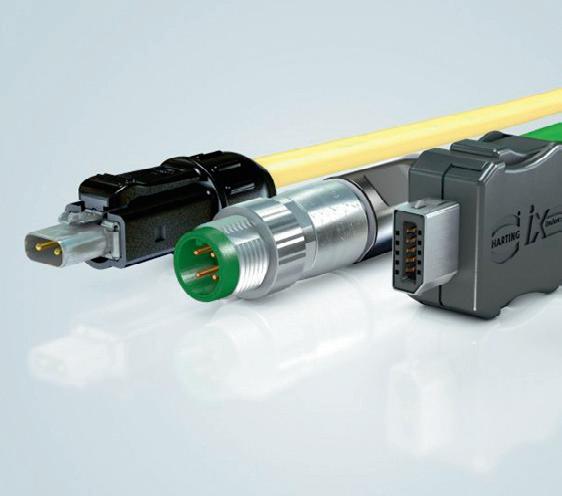
Designed with simplicity in mind, the T1 Industrial range of Single-Pair Ethernet connectors is easy to install and offers high connection security. It is also shock and vibration proof (according to railway standards) with 360° robust shielding, lowering the chances of failures and fault liabilities.
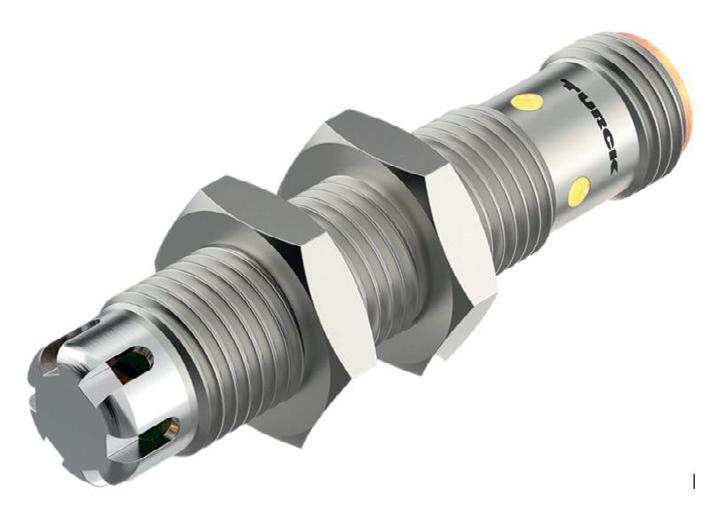
Paired with the SPE technology, the T1 Industrial offers barrier-free communication with up to 10 Gbps for automation networks and PoDL for remote power supply of sensors and actuators of up to 50 W, while at the same time being cost-efficient through higher packing density, faster installation, higher flexibility and weight-savings.
HARTING’s T1 Industrial is accredited by the international standardisation committees ISO/IEC, TIA and IEEE, and recommended for use in M 1I1C1E1, M2I2C2E2 and M3I3C3E3 environments. It is also suitable for all applications from IP20 to IP65/67.
The ix Industrial miniaturised Ethernet interface is said to be the key to future challenges posed by Industry 4.0 and the IoT. Based on industry standards according to IEC 61076-3-124, the ix Industrial is space-saving and encompasses a more robust plug-in connection while still producing Cat. 6A performance for 1/10 Gbps Ethernet at the control level.
HARTING Pty Ltd
www.harting.com.au
The FL MGUARD 2102 and FL MGUARD 4302 Gigabit security routers from Phoenix Contact combine mGuard security software with more powerful hardware and are designed to protect industrial networks against unauthorised access or malware intrusion.
With their increased data throughput of almost 1000 Mbps, the security routers provide a higher level of security without any restrictions on data traffic. The mGuard security technology enables users to control and safeguard communication within production networks. The routers are functionally compatible with the current mGuard modules, making it easy to use them in existing applications.
The FL MGUARD 2102 is recommended for machine builders and system manufacturers that require fast integration into the production network in addition to secure remote maintenance. As well as ensuring the security of the OT network infrastructure, the FL MGUARD 4302 enables the efficient management of multiple mGuard security routers within a system.
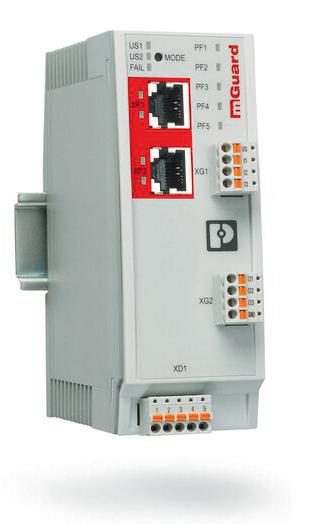
Phoenix Contact Pty Ltd www.phoenixcontact.com.au
Turck’s CMTH combined humidity and temperature sensor is now available in a compact variant with improved IIoT integration for smart condition monitoring applications. With a length of 57 mm and an operating temperature range from -40 to +100°C, the IP67 sensor in an M12 housing can be used in many challenging environments. The interface provided also supports easy integration, since the standard IO-Link Smart Sensor Profile (version 4.1.2.) with 64 bits on two channels simplifies the vendor-neutral configuration of networked systems.
The CMTH is particularly suitable for monitoring the climatic conditions in production and warehouse buildings for all sectors handling goods that are sensitive to humidity and temperature.
In simple I/O mode the sensor outputs one switching signal for temperature and one for humidity. This mode is particularly suitable for retrofitting to collect climatic data in existing applications where IO-Link is not available. IO-Link mode offers extra benefits in modern plants or machines as the CMTH smart sensor can not only output continuous process values but can, for example, also calculate the local dewpoint. Users requiring long-term analysis can take advantage of a pre-configured histogram function.
The digital interface also simplifies sensor commissioning. Turck’s IO-Link master can commission the device via the master’s integrated web browser, without the need for any additional software.
Turck Australia Pty Ltd
www.turck.com.au
The selection of a heatsink solution — also called a cold plate — as a thermal management solution for a system will ensure a constant and stable temperature, as well as a condensation-free electrical cabinet system, according to HYDAC Australia National Development Manager for Thermal Management Systems Andrea Cimadoro.
All electronic components can fail or have a reduced lifespan because of overheating. This includes an increase in temperature due to surrounding ambient temperature, heat produced by the device itself, and the product’s efficiency is strictly related to heat removal.
Modern electrical and electronic systems frequently include control devices, which are required to enhance efficient controllability. However, controllability often generates heat, which influences most heat-sensitive electrical components such as VSDs and controllers.
“In fact, 70% of the failures in electronic equipment are related to heat. That’s why it’s critical to control the temperature of the electronic components,” Cimadoro said.
Cimadoro points out that there are two techniques available to solve this problem:
• the passive heatsink
• the active (dynamic) heatsink
Passive heatsinks rely on natural convection, i.e. the tendency of hot air to rise causes air flow to be generated across the heatsink. These heatsinks do not require secondary power or control systems to remove heat.
“The passive heatsink is a fan, usually present at the back of every computer or variable speed drive unit,” said Cimadoro. “It can be cooled by air or by forced ventilation. In contrast, the active (dynamic) heatsink is a cold plate that allows fluid to travel inside to cool any electronic devices that are attached to it.”
However, this technique comes with many challenges, according to Cimadoro.
“In terms of efficiency, the electrical cabinet must be designed for the air to travel into it, and to be able to successfully reach and cool all the electronic components,” he said. “As for contamination, the fan allows the electrical control cabinet to breathe, but it also opens it to dirt, dust, humidity and also moisture.”
The heatsink solution developed by HYDAC eliminates these external factors.
“The main key to this innovation is the total isolation of the electrical control cabinet,” Cimadoro points out. “The cabinet is hermetically sealed; therefore, the environment inside the electrical box can be entirely controlled.”
The cold plates are installed on the external back end of the system, and are driven by a control fluid such as water, waterglycol, or other water-based fluid. This compact solution also provides a high internal protection rating of IP66, IP67 and IP68.


HYDAC cold plates are designed according to projects and specifications and, therefore, provide effective results.
“For instance, the cold plate can take all the back-end space of the electrical box; or it can be customised to be more effective in a certain area,” said Cimadoro. “HYDAC also thought about systems installed in hot and humid environments, which are often presented with condensation problems. By creating an innovative purging point onto the electrical control box, it is possible to insert 99% dry nitrogen and make the electrical box condensation-free.”

Progress towards the Fourth Industrial Revolution will rely heavily on wireless communications in the factory.
With the arrival of 5G technology, the manufacturing industry faces its biggest transformation yet. Safer, flexible and more efficient manufacturing systems will be possible due to the ultra-low-latency and reliability of 5G connectivity. This enables continued automation of robots and warehouse transportation as well as the cutting of cables for true flexibility.
During the last 200 years we have seen tremendous development in industrial production. During this time there has been a shift away from
craft production and towards mass production. Mass production was a result of a technology push to make manufacturing more productive.
With mass production we lost the ability to produce customised products. The customer need for customised products, however, is still there. For this reason there is a strong market pull to make industrial production far more flexible than it is today.
Flexible production, however, is not allowed to increase the cost of production. On the contrary there is a need to increase automation in order to maintain quality and stay competitive. In some regions competitiveness is the main driving force, while in others quality is the driving force.
During the last 30 years we have automated everything that can be automated in the factory using wired technology. The main processes that have so far not been automated are the integration of logistics, materials handling and factory automation.
The integration of logistics, materials handling and factory automation can only be achieved by using wireless technology. A vision of this is shown in Figure 1.

In this vision:
• A truck arriving with material for the factory announces its arrival to the factory and communicates directly with an AGV. The AGV unloads the truck and delivers the material to an assembly line.
• Assembly lines, machines and robots in the factory are connected wirelessly in order to maintain a high degree of flexibility.
• Workers are mobile and use wireless devices to monitor and control the factory.
• Finished products are placed in an automated warehouse before they are loaded onto a truck. The introduction of wireless technologies in industrial produc -
tion has already started. Today we see a multitude of wireless technologies being used for different use cases in industrial production.
Initially wireless technologies were used for select non-critical applications, but increasingly wireless technology is becoming the norm and is becoming more and more mission-critical.
None of the wireless technologies used today have the reliability, scalability and performance that are needed for tomorrow’s industrial production. But now, from a technical perspective, 5G cellular technology has the potential to meet all the requirements.

5G is the first cellular generation that specifically targets machine-to-machine communications. The different services are illustrated in Figure 2.
Massive Machine-type Communication (eMTC) allows vast numbers of battery-operated, low-power devices to be connected. From an industrial production perspective this type of service will enable:
• Wireless sensor networks
• Location and asset tracking.
Ultra-Reliable Low Latency Communications (URLLC) allows latency below 1 ms on the radio interface as well as availability exceeding 5-nines (99.999%). From an industrial production perspective this type of service will enable:
• Motion control
• Mobile robots
• Human remote control
• Mobile control panels with safety functions.
Enhanced Mobile Broadband (eMBB) is primarily targeting residential internet access with speed and latency on a par with fibre optic networks. From an industrial production perspective this type of service is suitable for:
• AGVs
• Augmented reality
• Remote access
• Inbound and outbound logistics.
For the first time in the history of industrial production a single wireless technology offers the solution to all aspects of communications within the factory. The only area not suitable for 5G within industrial production is motion control with sub-millisecond cycle time requirements.
5G is primarily intended for public networks in licensed bands, but it is also possible to use as a private network as a:

• Private network in an unlicensed band
• Private network in a licensed band (own radio licence or sublicensed from a cellular operator)
• Semi-private network using a slice of the public network. For some factory owners it is important to own and control the communications infrastructure. In this case it is relevant to use either unlicensed frequencies or to get a licence to operate in a licensed band.
The advantage of using unlicensed spectrum is that it is easy to deploy without obtaining a licence first. The downside is the possibility of interference from other users in the area as well as limitations in transmit power.
NONE OF THE WIRELESS TECHNOLOGIES USED TODAY HAVE THE RELIABILITY, SCALABILITY AND PERFORMANCE THAT ARE NEEDED FOR TOMORROW’S INDUSTRIAL PRODUCTION
In the case that the factory owner prefers to use licensed frequencies, a licence can be obtained from the government or alternatively sublicensed from a mobile operator.
Factory owners looking to outsource the operation of the factory 5G network can make an agreement with a public mobile operator to provide the service. The service level agreement will cover aspects such as availability, coverage, bandwidth, life cycle management etc.
Generally you get better coverage with lower frequencies. Lower frequencies, however, are also in high demand from mobile operators, broadcasters, emergency services and other users of the radio spectrum.
Licensed spectrum is available around 3.5 GHz as well as in the 26 GHz band in most countries. For unlicensed deployment of 5G the 5 GHz ISM band is a good candidate. In the 5 GHz ISM band 5G will be sharing the spectrum with WLAN.
The main driver for 5G within industrial production is to automate the processes that today cannot be automated using wired technology. There is, however, also a need to migrate some of today’s PLC communications from industrial Ethernet to 5G. The driver for this is increased flexibility, increased reliability and reduced cost for some use cases.
5G PLC communications might only be a small fraction of the total traffic on the 5G factory network. It is, however, the most demanding due to requirements for real-time performance and reliability. For PLC communications, we need low latency and high availability. Low latency and high availability is already supported by the 5G new radio (NR) interface. Only in the case of motion control applications will 5G not be fast enough.
Unfortunately most industrial Ethernet protocols do not rely on TCP/ IP and have various extensions to the Ethernet standard in order to support low latency and high reliability. With today’s cellular standards only TCP/IP traffic is supported. This means that most of the industrial Ethernet protocols listed in Figure 6 will not be compatible with 5G.
Only EtherNet/IP and Modbus/TCP will be supported on 5G directly.
In order to improve the support of industrial Ethernet, 3GPP is standardising Ethernet as a service on 5G. This standardisation also includes the support of time sensitive networks (TSN). At the same time most industrial Ethernet protocols are being updated in order to replace proprietary real-time extensions with TSN. This means that once this standardisation work is finalised it will be possible to more fully support industrial Ethernet on 5G networks.
In the meantime it is possible to deploy gateways that adapt the industrial Ethernet protocols to 5G. An example of this is shown in Figure 3.
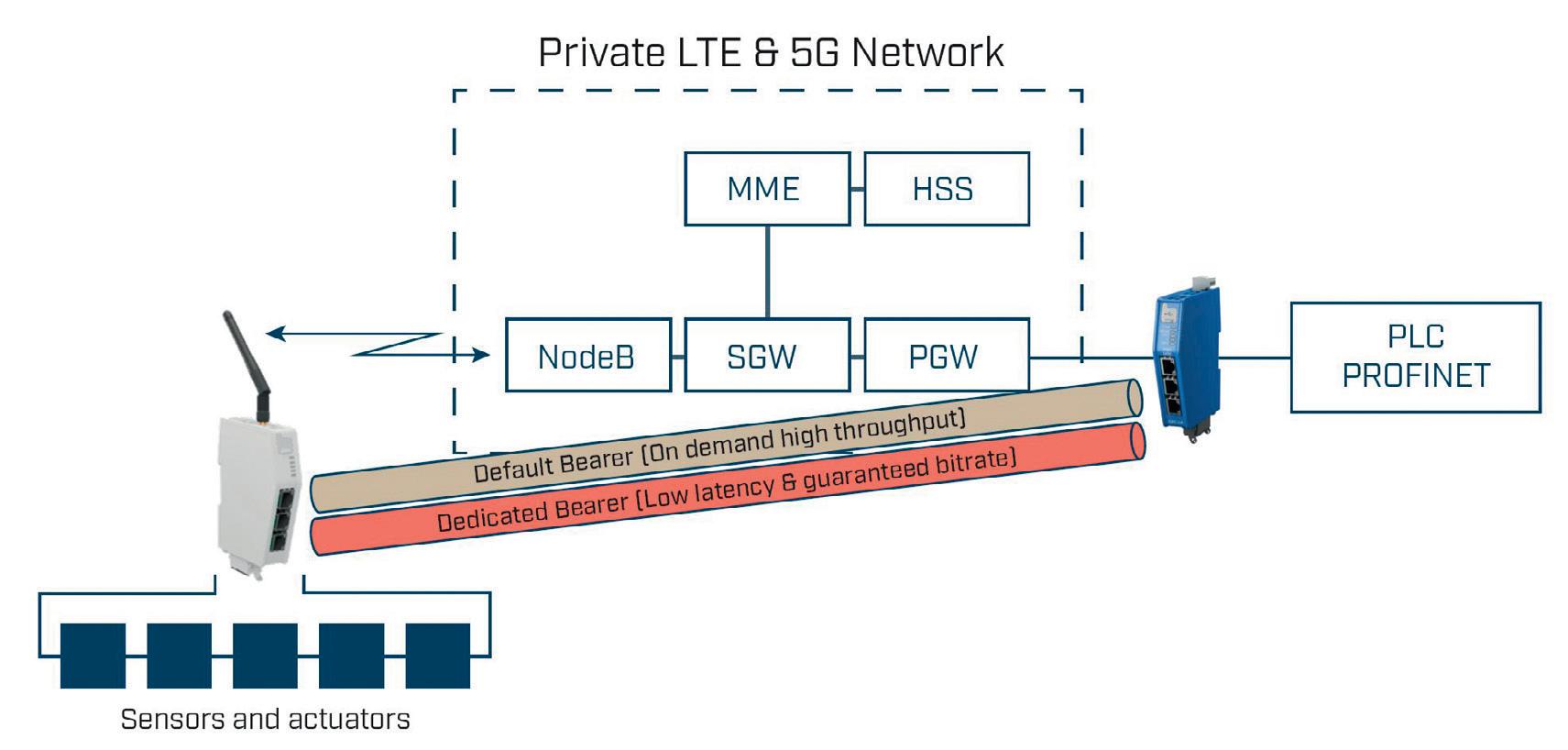
In this example Ethernet is tunnelled over IP and the IP qualityof-service header field is marked depending on the real-time requirements of the underlying PROFINET traffic. On the cellular network the non-real-time traffic is carried using a default bearer. Real-time traffic on the other hand is carried on a dedicated bearer which provides a guaranteed bit rate and low latency. With this setup it is possible to support industrial Ethernet on 5G with cycle times down to a couple of milliseconds.
Industrial production is undergoing its fourth revolution. The goal is to increase flexibility and at the same time increase automation. Ideally production in the factory should be handled completely without any manual tasks. Only in case of failures or other exceptional cases should humans need to intervene.
The fourth industrial revolution can only succeed by relying heavily on wireless communications in the factory. From a technical perspective 5G is the technology that is best suited for the future factory.
1. 5G-ACAI 2021, 5G for Connected Industries and Automation, <<https://5g-acia. org/wp-content/uploads/2021/04/WP_5G_for_Connected_Industries_and_Automation_Download_19.03.19.pdf>>
Pepperl+Fuchs’ latest SIL 3 output drivers close the gap in the Pepperl+Fuchs range of SIL 3 components. Intrinsically safe SIL 3 components are now available for all signal types — digital and analog, for control signals to the actuators and for measurement signals from the field, as devices for DIN rail mounting and as isolating components for termination boards.
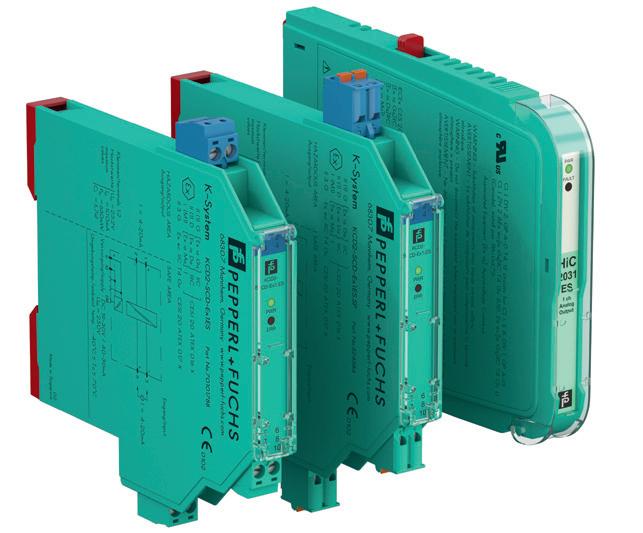
For practical applications, this means that the previously necessary workaround with redundant SIL 2 components is no longer necessary for SIL 3 applications: positioners, electric valves or HART IP converters in intrinsically safe SIL 3 applications can now be connected directly to the control system with a single safety barrier.
Pepperl+Fuchs (Aust) Pty Ltd www.pepperl-fuchs.com
IDEC Corporation has developed the HT4P Safety Commander, improving on the previous HT3P by incorporating end user feature requests for additional networking and operator interface functionality. The HT4P Safety Commander is an ergonomic device enabling users to securely hold and protect an HMI tablet, while providing power, networking, hardwired emergency stop (e-stop) and other operator interface devices. It enables OEMs and automation designers to provide flexible and safety-rated operator interface options for equipment, robotics, collaborative robots, automated guided vehicles (AGVs), autonomous mobile robots (AMRs) and other manufacturing system applications.
Modern consumer-grade tablets offer a better visualisation solution than most specialised HMIs or teaching pendants, especially for data-intensive industrial internet of things (IIoT) applications. They can also offer viewing of drawings and manuals, videoconferencing, and reports, but they are not made to withstand industrial conditions.
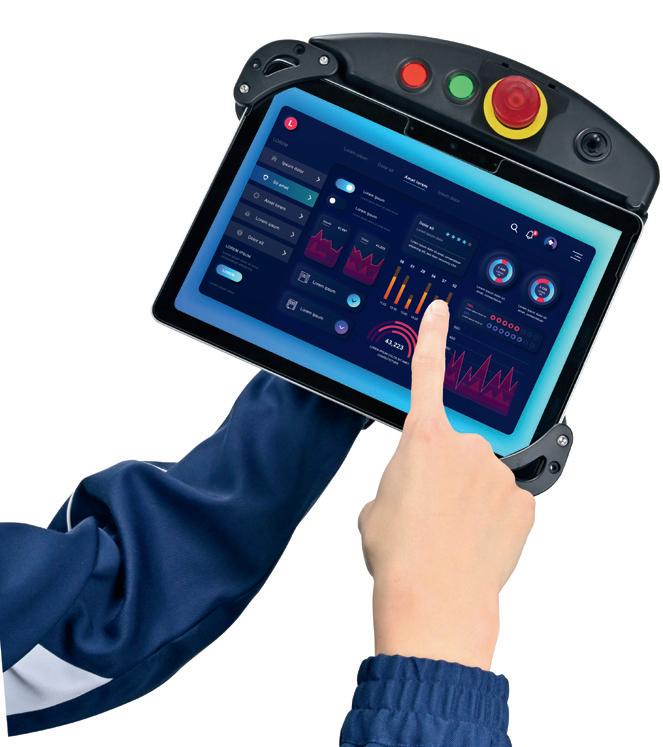
The Safety Commander devices provide a ruggedised way of deploying HMI tablets to deliver many convenience and productivity benefits, in an arrangement designed for use on the factory floor.
The HT4P Safety Commander builds on the capabilities of the HT3P and has been enhanced with the ability to hold larger tablets up to a 13-inch using adjustable grippers. It now also offers the choice of wired networking in addition to Wi-Fi where electrical noise or other conditions make wireless unsuitable.
It also now has three on-board mounting positions capable of providing standard or custom arrangements of hardwired pushbuttons, illuminated pushbuttons, and selector switches, with a guard available to protect against inadvertent operation of the e-stop button.
IDEC Australia Pty Ltd
www.idec.com/australia
The ICP DAS FSM-510G-2F is a high-performance Layer 2 managed switch that is suitable for small and medium-sized networks. The switch offers features designed to enhance network manageability, security, QoS and performance. It comes with eight 10/100/1000 Mbps Ethernet ports and two SFP ports that support up to 1 Gbps speeds.

One of the features of the FSM-510G-2F is its network redundant ring fail-over protection, which provides seamless network operation in case of a network failure, with a failover time of less than 20 ms.
The switch also supports multicast traffic through IGMP v1/v2/v3, proxy, and snooping, allowing for efficient distribution of multimedia content across the network. It also features multicast/broadcast/flooding storm control that limits the impact of broadcast and multicast storms on network performance.
The FSM-510G-2F can be easily managed through various methods, including telnet, web-based management and an SNMP agent. The SNMP agent enables network administrators to log in to the switch to monitor, configure and control each port activity in a user-friendly way. It also comprehensive functions such as QoS, Spanning Tree, VLAN, port trunking, bandwidth control, port security and RMON.
ICP Electronics Australia Pty Ltd
www.icp-australia.com.au
Interworld Electronics has introduced the BOXER-6645-ADS rugged fanless embedded box PC from AAEON Technology. The BOXER-6645-ADS contains high processing capabilities with up to 16 cores and 24 threads using 12th Generation Intel Core i3/i5/i7/i9 processor platforms, providing broad potential for applications that demand high-performance computing, alongside I/O featuring four independent display interfaces and multiple LAN ports.

The BOXER-6645-ADS is built to withstand harsh environments, including extreme temperatures (-20 to 60°C), shock, vibration and humidity. The system is housed in a durable aluminium chassis that protects it from dust and other environmental factors. Along with its wide 12–24 VDC power input range, the BOXER-6645-ADS is suitable for continuous operation in the most extreme deployment environments.
The BOXER-6645-ADS offers up to eight 10 Gbps USB 3.2 Gen 2 slots for high-speed peripherals, four LAN ports for camera and sensor connectivity, and four independent display outputs. Additionally, it is equipped with the latest M.2 expansion capability, housing M.2 2230 and M.2 2252 slots to facilitate both Wi-Fi and 5G modules.
It also comes with a range of integrated peripheral technologies, including Intel DL Boost and Intel Iris Xe Graphics to enable high AI inferencing performance. It also supports up to 64 GB DDR5 SODIMM system memory, which significantly boosts data rate transfer speed.
Interworld Electronics and Computer Industries www.ieci.com.au
The smartLink SW-HT HART multiplexer software from Softing Industrial, designed for accessing configuration and diagnostic data, now supports ET200 remote I/Os from Siemens and the FDT DTM interface.
The Docker container-based software application is designed to allow easy and fast access to HART devices connected to remote I/Os that can be reached via Ethernet. No additional hardware is required for this. It has so far enabled the use of remote I/Os from Allen-Bradley, Schneider Electric and R. Stahl. The current version 1.30 now also supports ET200 remote I/Os from Siemens and the FDT DTM interface.
Configuration and diagnostic data are accessed via Emerson’s AMS Device Manager or other HART IP-enabled plant asset management applications. The product provides an Ethernet connection for tunnelling the HART commands to the remote I/Os.
On the field side, the software is designed to be low risk and easy to integrate. This is even possible during operation and does not require a plant shutdown. The application makes it easy for users to implement open, standards-based and scalable system architectures and to integrate connectivity into edge solutions managed by IT.
Softing Industrial Automation GmbH
www.industrial.softing.com
Moxa has introduced a range of industrial wireless networking solutions, featuring the AWK-3252A, AWK-4252A, and AWK-1151C Series AP/bridge/clients. The updated AWK range offers 802.11ac performance, IEC 62443-4-2 SL2 certified security, and dual-band Turbo Roaming for wireless reliability and availability. The company says these features meet the current and future demands of mobile automation and IP surveillance in mining, manufacturing and many other industries.
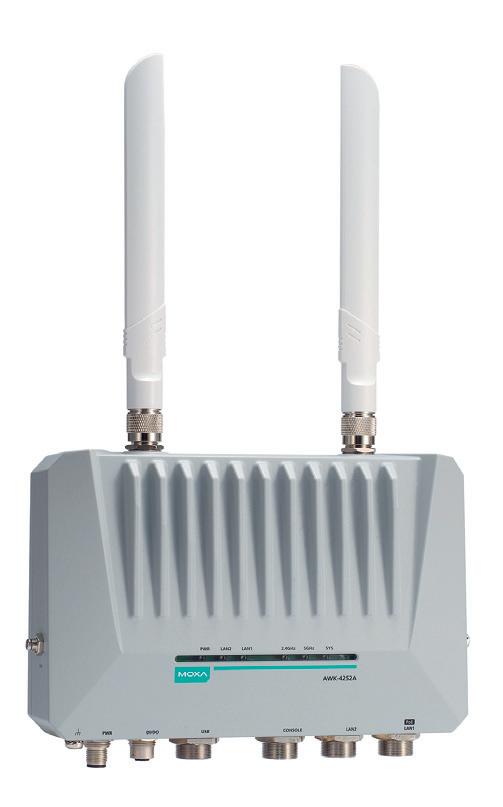
Moxa’s latest AWK Series is designed to simplify wireless operations and the integration of mobile systems outfitted with complex sensors and cameras, while offering high performance to address the requirements for reliable and futureproof systems. With speeds of up to 400 Mbps on the 2.4 GHz band and 867 Mbps on the 5 GHz band, the AWK Series enables a high-bandwidth, dynamic mobile environment to accommodate a large number of devices and support high-volume data communication. In addition, support for one-to-many network address translation (1-to-n NAT) optimises the machine integration flow by simplifying IP address assignment while avoiding IP conflicts between existing devices connecting to the OT network wirelessly.
Based on the principle of secure-by-design, the AWK-3252A, AWK-4252A, and AWK-1151C Series industrial Wi-Fi devices are certified for IEC 62443-4-2 by the IECEE. Compliance with this standard not only supports device-level security for industrial automation and control systems (IACS), but also verifies that these AWK devices are suitable for building an IEC 62443-3-3 compliant security environment. The range also supports the latest WPA3 encryption for an additional layer of WLAN security.
Colterlec Pty Ltd
www.colterlec.com.au
The BRx42 PMDC motor is a high-efficiency motor that comes in two stack length models, the BRx42-25 and BRx42-40. It is housed in a zinc metal enclosure and a steel tube that is sealed to IP54 (with IP67 available on request) to protect it from dust particles and water spray. It has a compact envelope size and is lightweight, making it suitable for a wide range of applications in industries such as agriculture, medical, industrial and building automation.
The motor offers a selection of voltages up to 48 VDC and is continuously rated at up to 57 mNm, delivering up to 90 mNm intermittently. It supports bidirectional operation and can be customised with special shaft designs and windings if required. The motor features high-end ball bearings at the front and rear, for low noise and vibration resistance, and is said to have a long lifetime due to its quality components in the multi-bar mechanical commutation.
The operating temperature of the motor ranges from -30 to +100°C, with an ambient temperature of 40°C. The motor is UL, ETL, CSA approved, and EMC EN 61000-6-3: 2007 +A1:2011 suppression is optional.
The BRx42 PMDC motor can be combined with Parvalux encoders, controllers and gearheads as part of a modular system.

maxon motor Australia Pty Ltd www.maxonmotor.com.au
Cognex Corporation has released the DataMan 282 fixed-mount barcode reader, outfitted with the company’s high-powered integrated torch (HPIT) and optional dome lighting attachment. These lighting components enhance the reader’s ability to read direct-part marks (DPMs) by optimising lighting contrast and minimising glare and background interference.

DPMs are notoriously difficult to read as they are often imprinted on curved, shiny metal surfaces, such as electric vehicle (EV) components, consumer electronics and medical devices. These challenging surfaces cause some barcode readers to pick up too much glare, failing to illuminate the component or isolate the code.
The dome diffuser is designed to help deliver high read rates on direct-part marks by illuminating components while minimising background noise, even on reflective surfaces.
In addition, the HPIT enables users to change between red, white, blue and green lighting options with a single click. Multicolour lighting allows users to pair the right lighting colour with their application, helping to increase image contrast and leading to higher read rates and throughput.
Automation Systems and Controls Pty Ltd
www.asconline.com.au
Seeq Corporation has announced its Seeq Solution for Microsoft Sustainability Manager. The solution enables sustainability teams to extend the power of Microsoft Sustainability Manager, a Microsoft Cloud for Sustainability solution, to integrate time series process data preparation, analysis and continuous improvement, reducing the environmental impact of process industry operations.
Analysing time series data from sensors is critical for measuring sustainability impact at process manufacturing companies. Microsoft Sustainability Manager is designed to enable these organisations to unify their data to record, report and reduce their environmental impact. By leveraging the Seeq Solution for Microsoft Sustainability Manager, Seeq says it is possible to decrease data connectivity, preparation and analytics efforts.
With the solution, the Microsoft Cloud for Sustainability data model is incorporated into the Seeq workflow for consistency of emissions data. Process experts can leverage Seeq’s live data connectivity and auditable data cleansing and contextualisation capabilities to enrich their time series emissions data, reducing manual data preparation time by up to 80%, according to the company. Sustainability teams can then access this contextualised data within Microsoft Sustainability Manager to track direct (Scope 1) and indirect (Scope 2) emissions for reports and to set and track emissions reduction goals.
In addition to providing access to the operational data for the corporate sustainability teams, Seeq says the solution empowers subject matter experts to identify root causes of issues and opportunities for optimisation on an asset operations level.
Seeq Corporation
www.seeq.com
Australia has set the goal for 70% of plastic packaging to be recycled or composted by 2025, and for unnecessary single-use plastic packaging to be phased out. However, of the 1.1 million tonnes of plastic packaging placed on the market in 2020, only 16% or 179,000 tonnes was recovered, according to data published in the Australian Packaging Covenant Organisation’s Collective Impact Report in November 2021.
To help the country meet its recycling targets, the NSW Government introduced the Waste Less, Recycle More initiative which dedicated $337 million in funding to large-scale recycling projects.

One such worthy recipient of this initiative is Circular Plastics Australia (a joint venture between Pact Group, Cleanaway Waste Management, Asahi Beverages and Coca-Cola Europacific Partners), which with the additional support of the Australian Government’s Recycling Modernisation Fund, constructed a new PET plastic recycling facility in Albury, NSW.
The $50 million facility, operated by Pact, is capable of processing the equivalent of around 1 billion 600 ml PET plastic beverage bottles, collected via Container Deposit Schemes and kerbside recycling each year.
The bottles are then converted into more than 20,000 tonnes of high-quality plastic resin using state-of-the-art sorting, washing, decontamination and extrusion technology. The food-grade recycled PET (rPET) produced by the facility will be used to manufacture new beverage and water bottles for Asahi Beverages and Coca-Cola Europacific Partners, and new food and beverage packaging for Pact Group’s customers.
“The large-scale recycling of PET plastic bottles and packaging plays a crucial role in helping Australia to reduce its waste and become more sustainable,” said Richard Roberts, National Industry 4.0 Operations Manager at ZI-Argus Australia and member of the Open IIoT Group (a cohort that includes SMC Corporation Australia New Zealand, NORD Drivesystems, Balluff, Beckhoff Automation and KUKA Robotics).
“But to ensure that the recycled products are safe for consumers and meet the stringent standards set by corporates and lawmakers, an effective Industry 4.0 solution needed to be implemented across the plant’s production line for monitoring and traceability purposes,” he said.
This requirement resulted in Circular Plastics Australia contracting ZI-Argus to deploy their redundant, clustered cloud-connected solution known as Symbiont to connect all plant systems from infeed to output.
This includes the weight of material entering the facility, tracked throughout the process to output of the final product.
“The Industry 4.0 solution also tracks and monitors all equipment including major processing lines for sorting and washing, extrusion and decontamination, auxiliary machinery and plant services. This enables the automated collection of data for raw material consumption, production and scrap,” Roberts said. “Its sophisticated design is configured with redundant servers, such that in the event of an outage the services will recover appropriately by failing over to a redundant service or server which is a major benefit in a high-output production facility such as the recycling plant.”
Symbiont’s endpoints are connected to a variety of PLCs, controllers, APIs, databases and weigh controllers, creating a central data lake of 3000 data points. The solution enables cloud access from anywhere and provides plant workers with real-time dashboards and reports for production status, monitoring, historical analytics (up to 10 years’ worth) and insights.
Understanding that equipment monitoring is a crucial feature of IIoT integration, Symbiont includes custom alerts across all plant systems to provide warnings, escalations and detailed information on active issues. The data shared by these alerts allows operators, plant managers, group managers and even the CEO if needed to be informed and visually aware of what is happening in their plant for more effective production and system utilisation.
Other benefits of IIoT connectivity experienced by Circular Plastics Australia in their plant include data visualisation for product traceability and audit/verification purposes, and a traceability chain that covers feedstock material all the way to resin output. This chain is then scalable to include additional upstream and downstream data sources.
“Many manufacturers do not realise that cloud deployment and software are essential components to ensure continued efficiency in the case of system failure,” Roberts said. “Symbiont is unique in that it is programmed with a self-healing mindset, and therefore services can self-heal autonomously in the event of exemptions in the code or failures. This promotes minimal downtime of each individual service.”
Open
Tertiary education aims to equip you with the understanding of how to use the tools utilised within the workforce. However, it only prepares you so well for the multitude of working environments and tasks that graduate engineers face when entering their field. As a graduate engineer, I have only recently made this transition from student to a fully-fledged member of the workforce.
In applying for graduate positions, a commonly asked question during the interview process is: “Why did you choose to apply for this position?” The open secret is that while applicants will have prepared an answer specific to each company, most graduates likely applied simply because it was a job on a list.
I was lucky that the program I applied for and was later offered a position in was a structured graduate program that would provide me the opportunity to rotate through and spend time with various teams throughout the business. As such, when asked the above question during an interview, I could answer genuinely that I did so as I believed that it would provide me the opportunity to find where I could work best.

In just my first year of being exposed to the engineering industry I have been involved with projects, onsite commissioning, proposals and sales teams.
In the time that I spent working onsite I interacted with people with a diverse range of job descriptions, and an even more diverse set of working backgrounds. From technicians with intimate knowledge of the installation and maintenance of field devices, to the control room operators capable of reciting complex procedures at will.
During my time working with the projects team I have also had the opportunity to

Westwick-Farrow Media A.B.N. 22 152 305 336 www.wfmedia.com.au
Head Office Unit 7, 6-8 Byfield Street, North Ryde Locked Bag 2226, North Ryde BC NSW 1670 AUSTRALIA ph: +61 2 9168 2500
Editor Glenn Johnson pt@wfmedia.com.au
Acting Publishing Director/MD
Janice Williams
work with the engineers responsible for the coding of automation processes for projects of various sizes and functions.

Most recently, my time spent with proposal and sales engineers has given me a better understanding of how each of these teams collaborate to form a cohesive solution to any given engineering problem.
These rotations through each different team have provided me with a more holistic understanding of the business and a better understanding of the career path that I want to pursue. However, graduate programs that provide these opportunities are disturbingly scarce despite being highly sought after.
All this is to state the obvious: that engineering is a vast discipline that can cover numerous roles within a business. However, remembering this in the context of a newly graduated 20-something-year-old engineer is important. Completing tertiary education alone is not enough to navigate where their path in industry will take them. It is important that graduate engineers are provided the opportunities and support to find where their skill set is best applied, for their own individual success and the success of their employers. And it is my personal hope that the rotational style graduate program that I have been fortunate to be involved in becomes the norm to enable this.
Art Director/Production Manager Julie Wright
Art/Production
Linda Klobusiak, Marija Tutkovska
Circulation
Dianna Alberry circulation@wfmedia.com.au
Copy Control
Mitchie Mullins copy@wfmedia.com.au
Advertising Sales
Sandra Romanin – 0414 558 464 sromanin@wfmedia.com.au
Tim Thompson – 0421 623 958 tthompson@wfmedia.com.au
If you have any queries regarding our privacy policy please email privacy@wfmedia.com.au
Contact the editor
devices and precautions are installed and safe working procedures adopted before the use of any equipment found or purchased through the information we provide. Further, all performance criteria was provided by the representative company concerned and any dispute should be referred to them. Information indicating that products are made in Australia or New Zealand is supplied by the source company. Westwick Farrow P/L does not quantify the amount of local content or the accuracy of the statement made by the source.
all necessary




